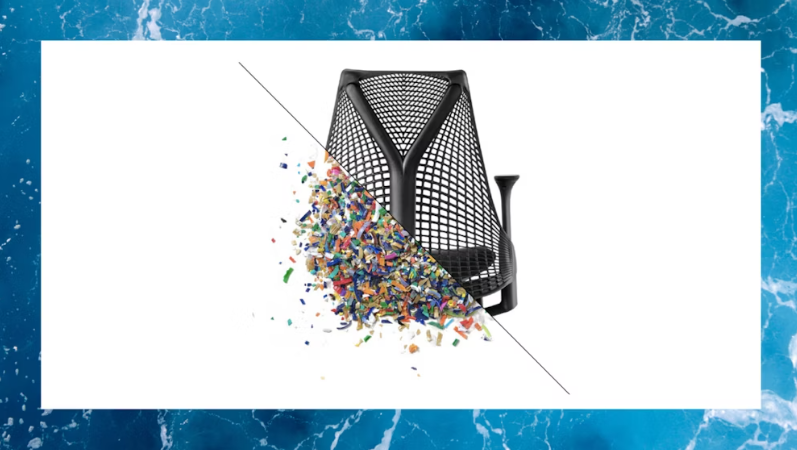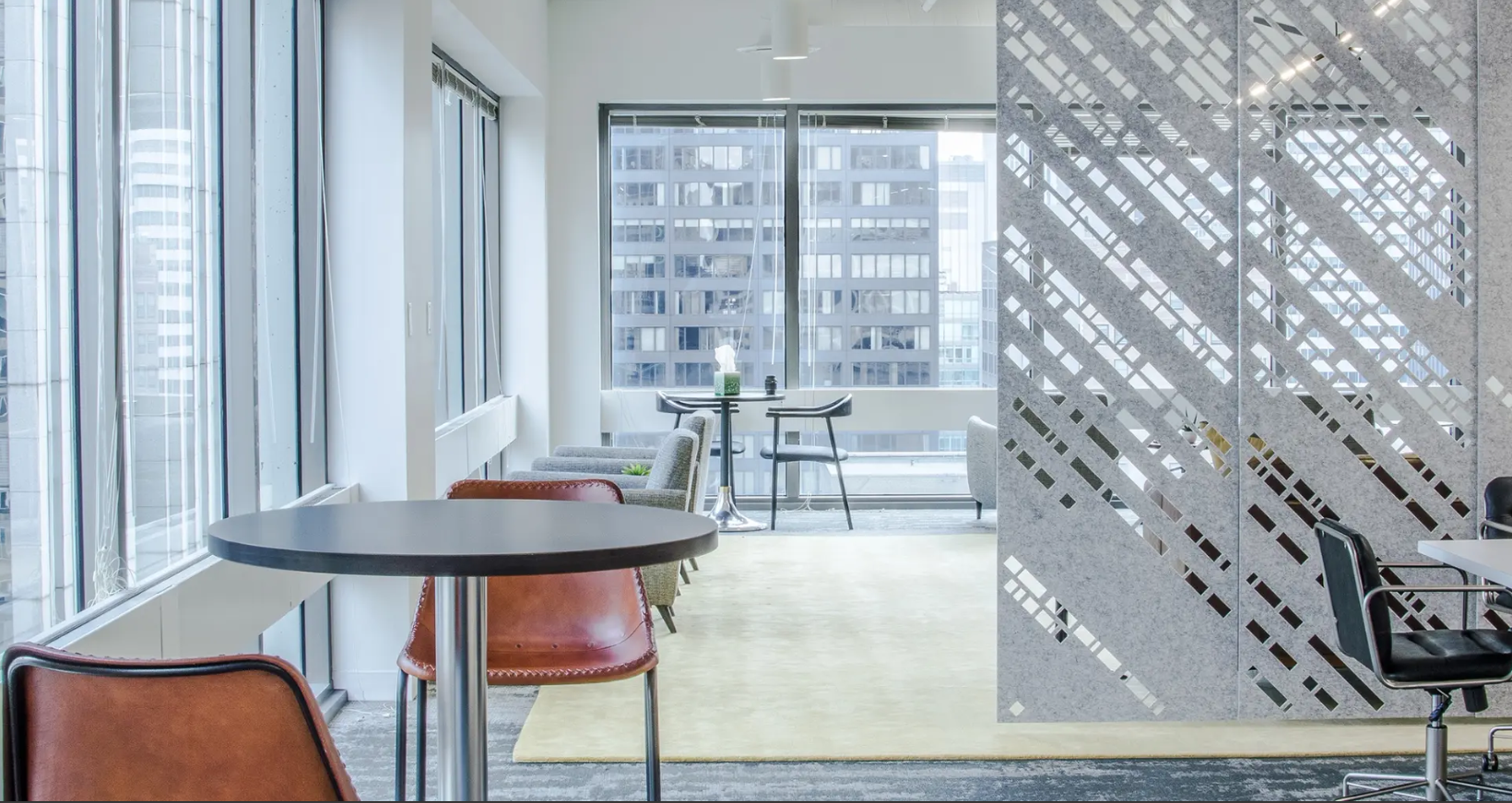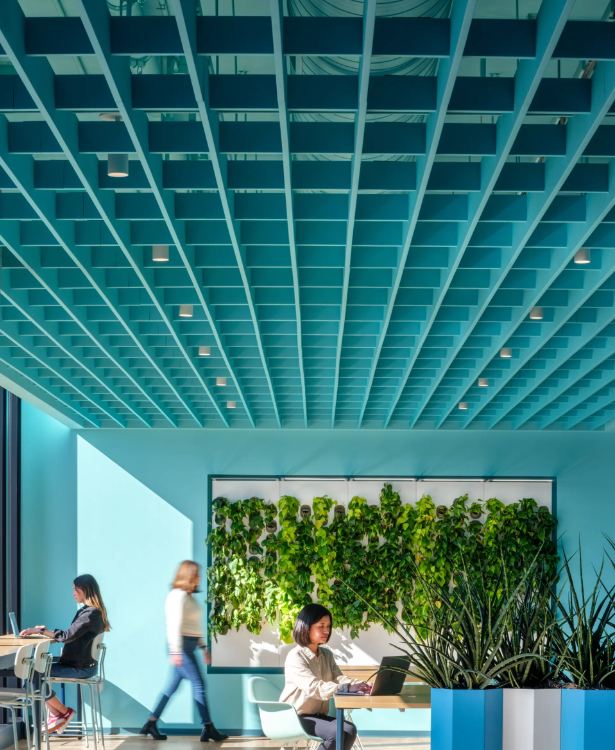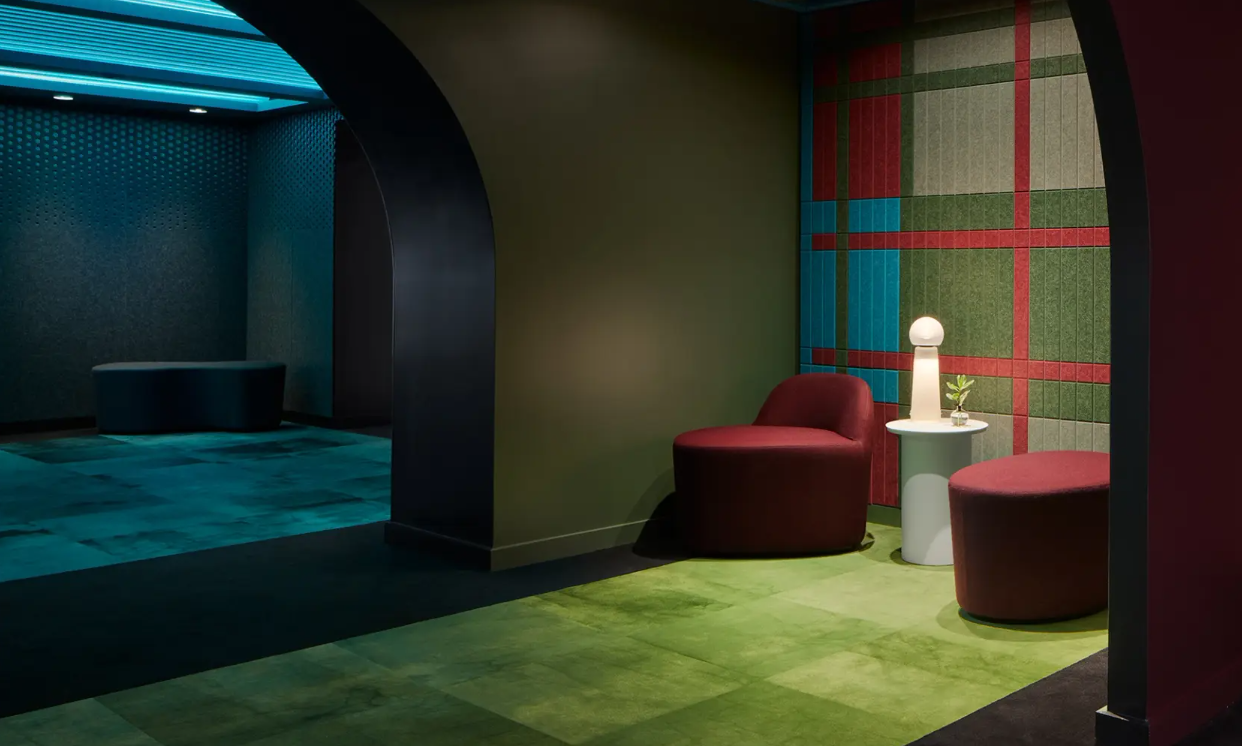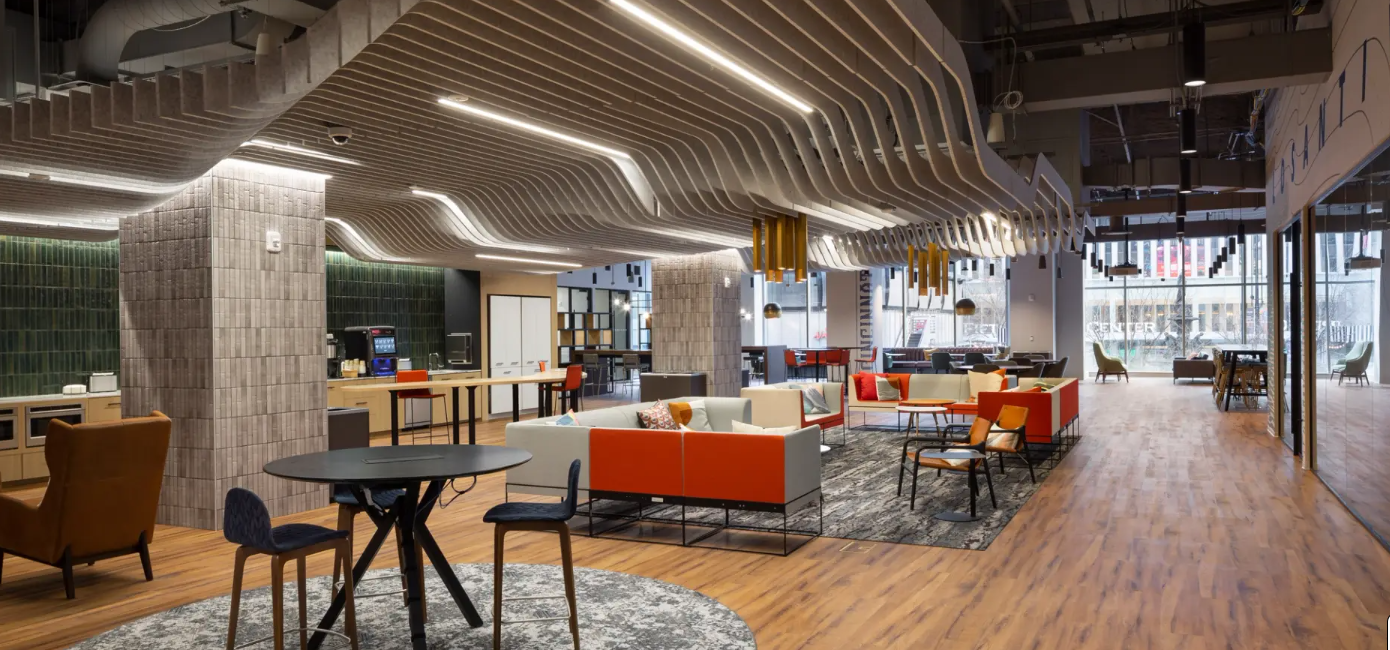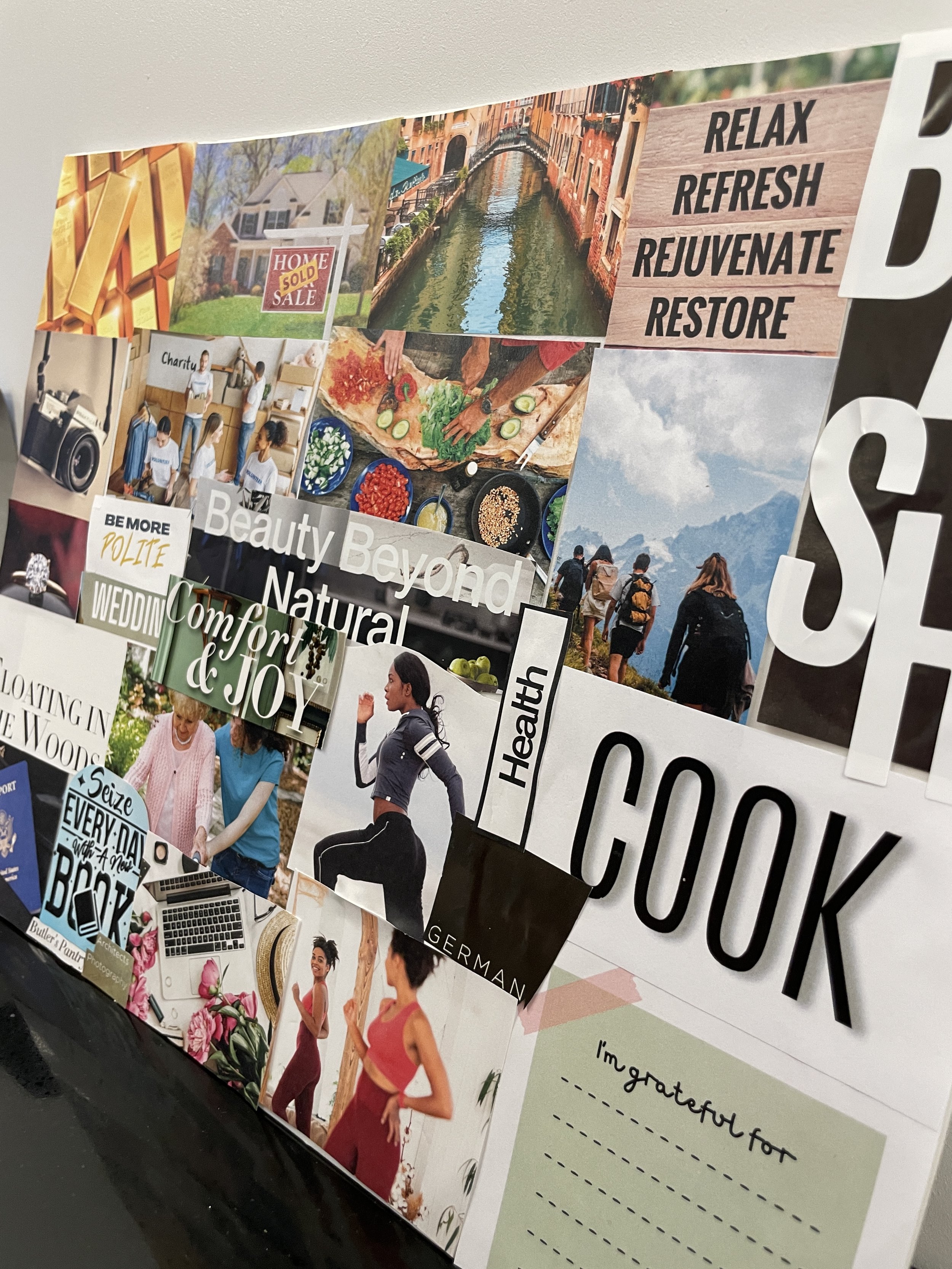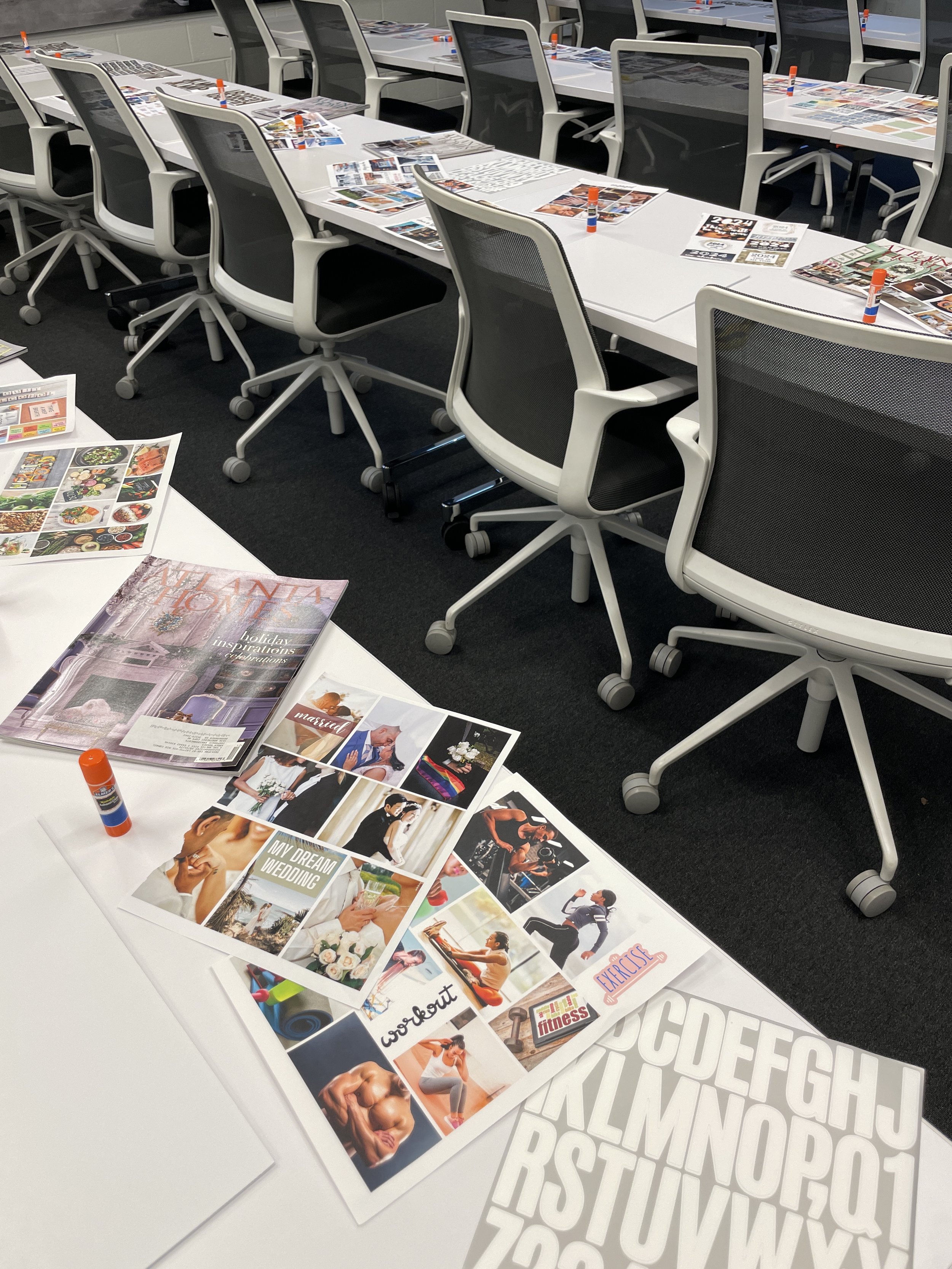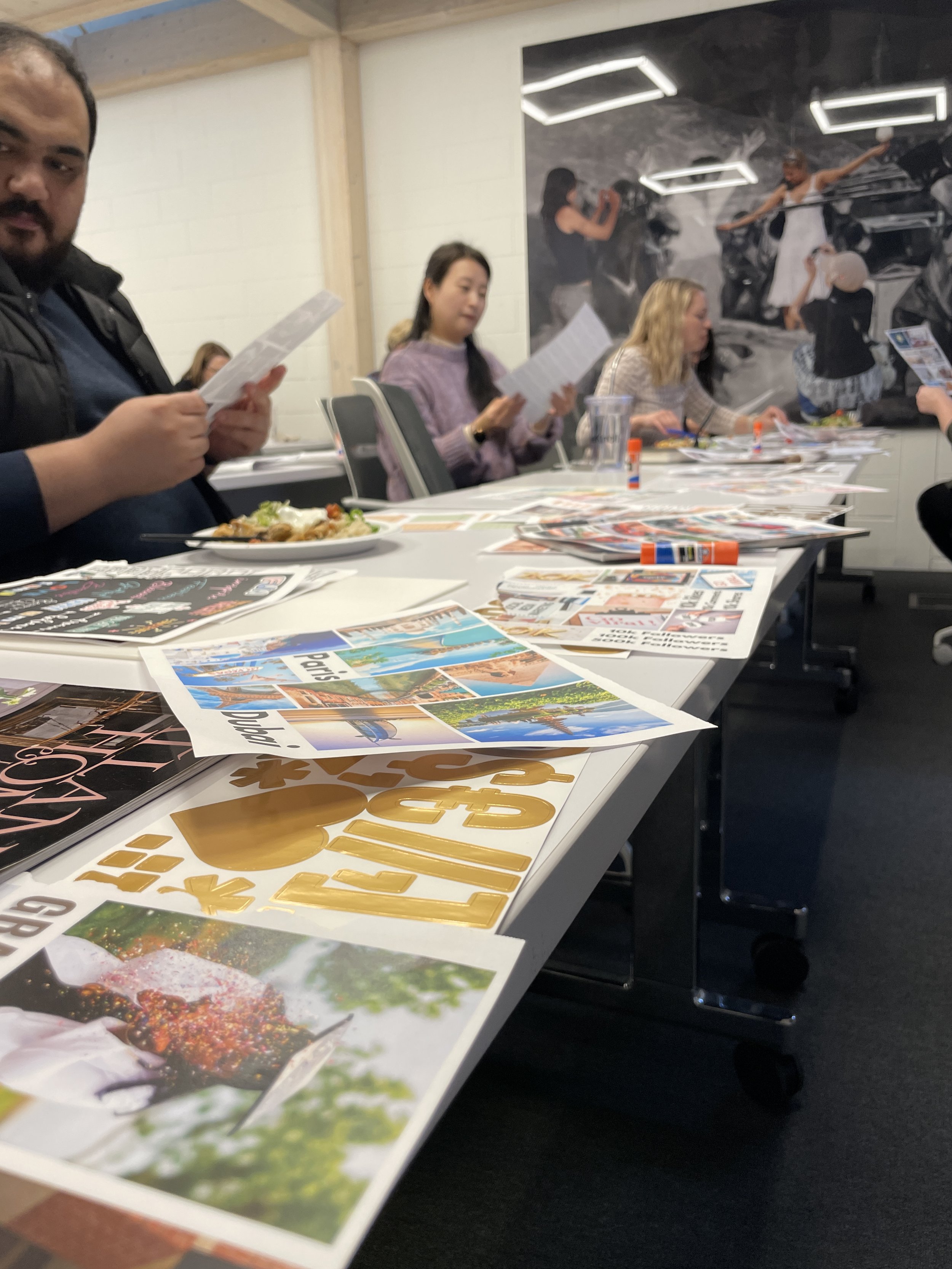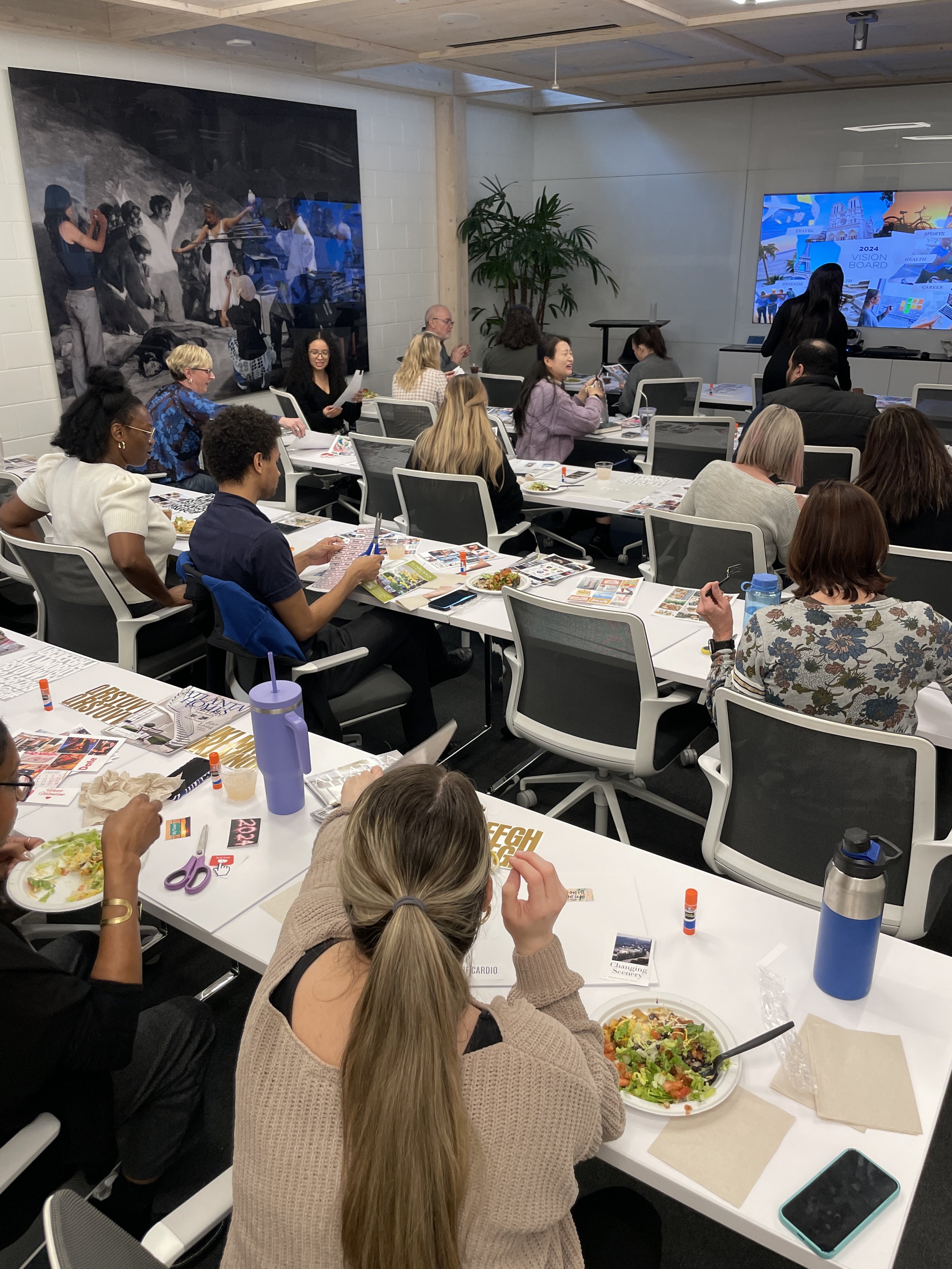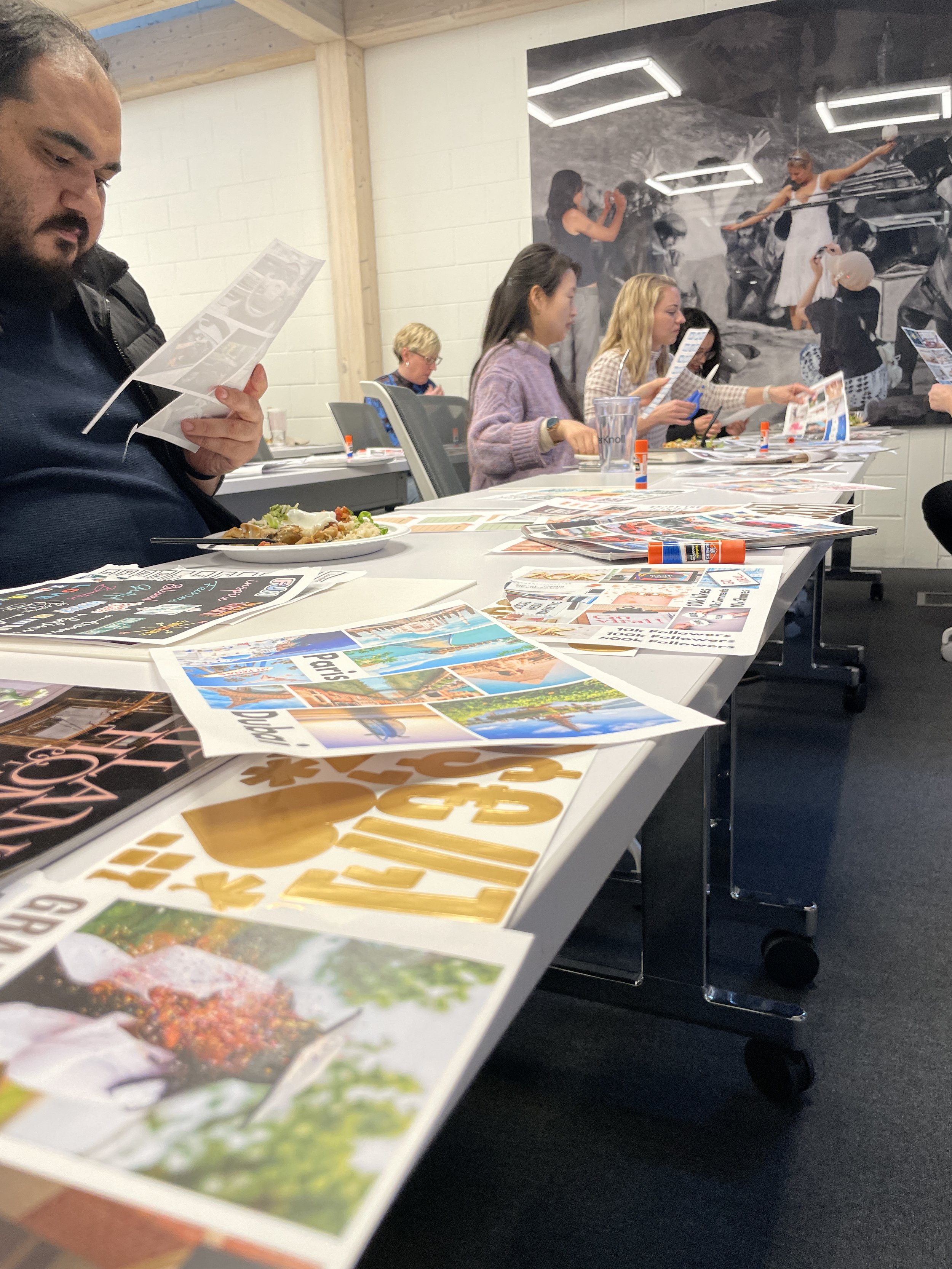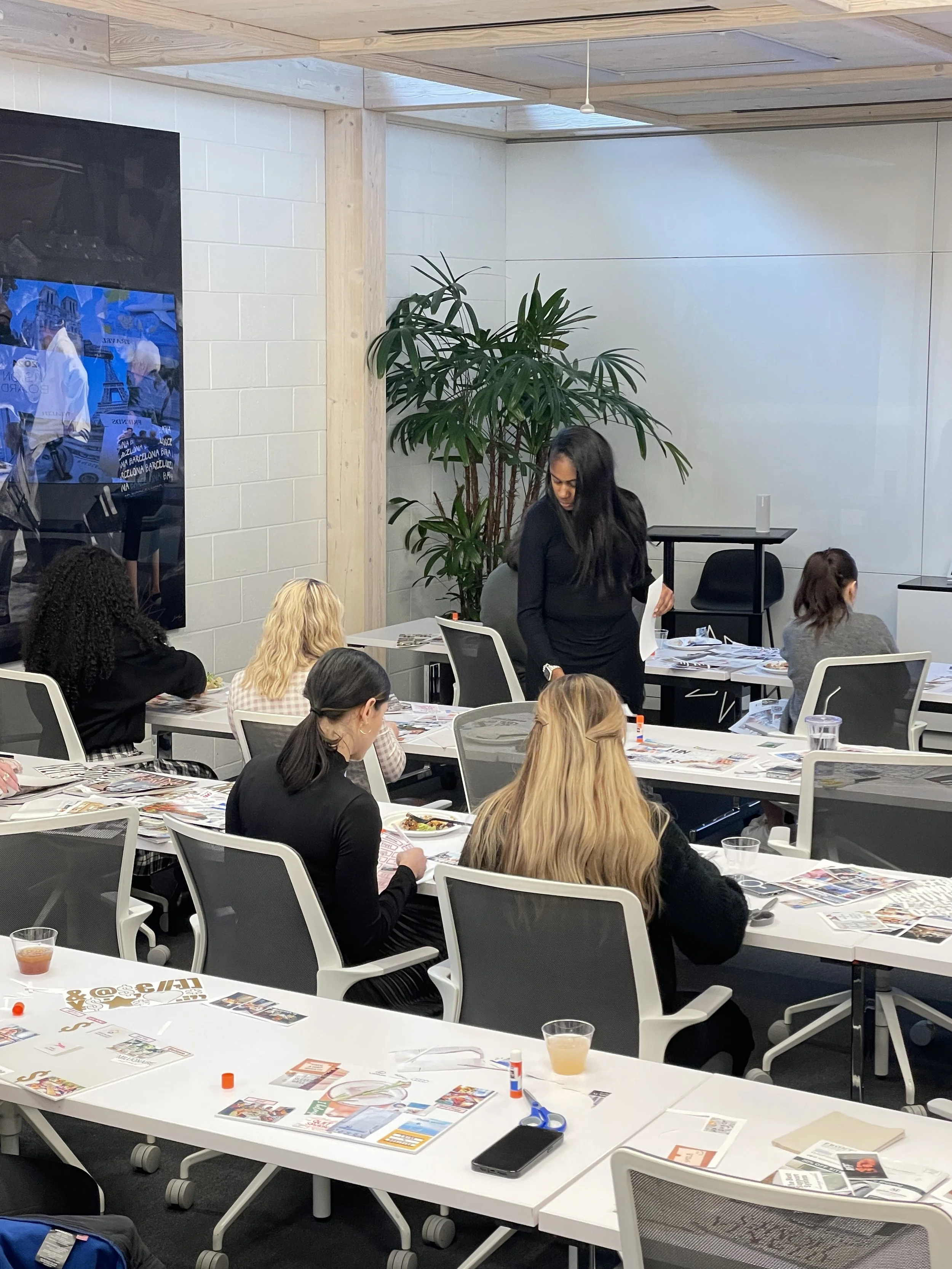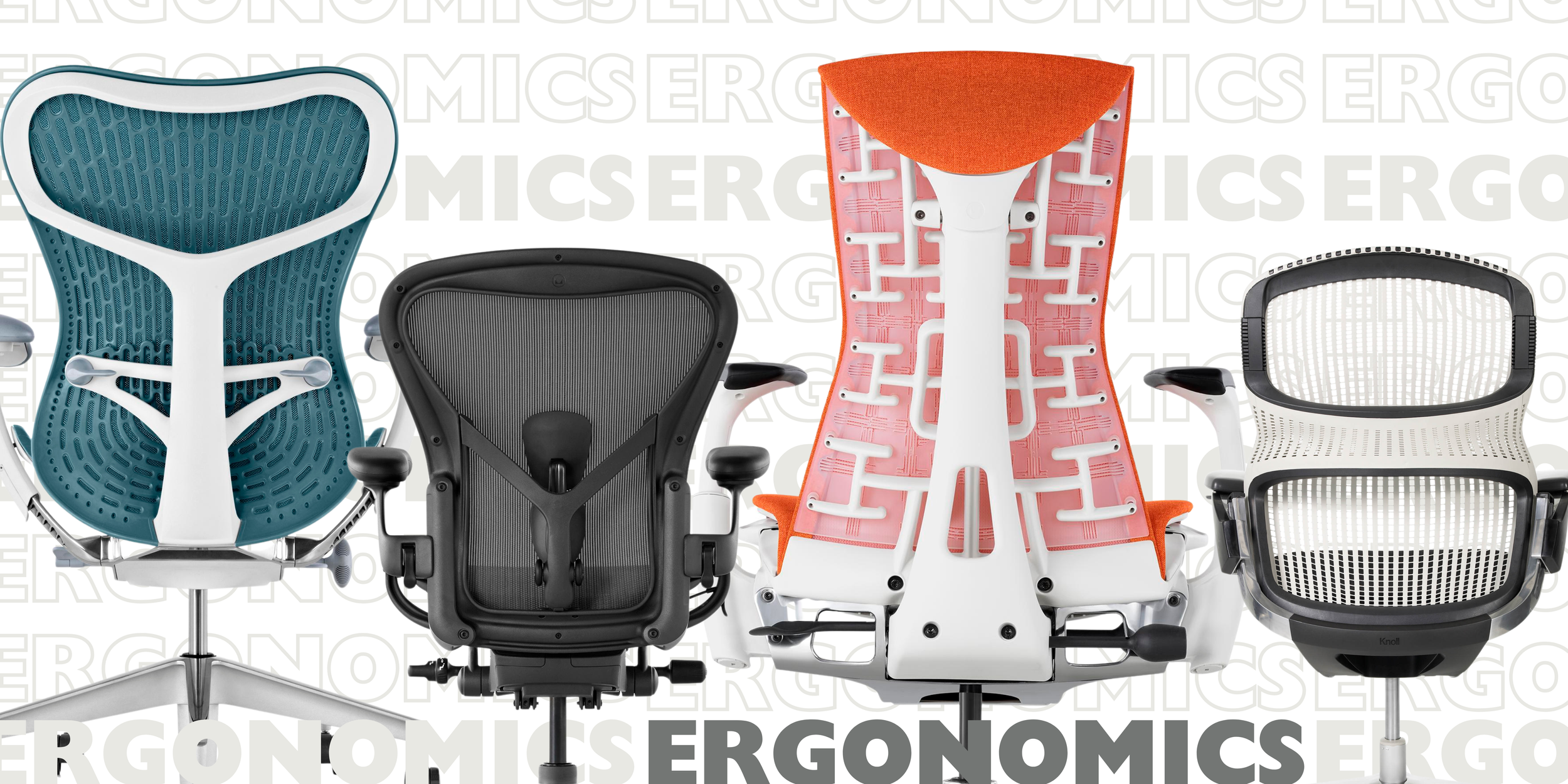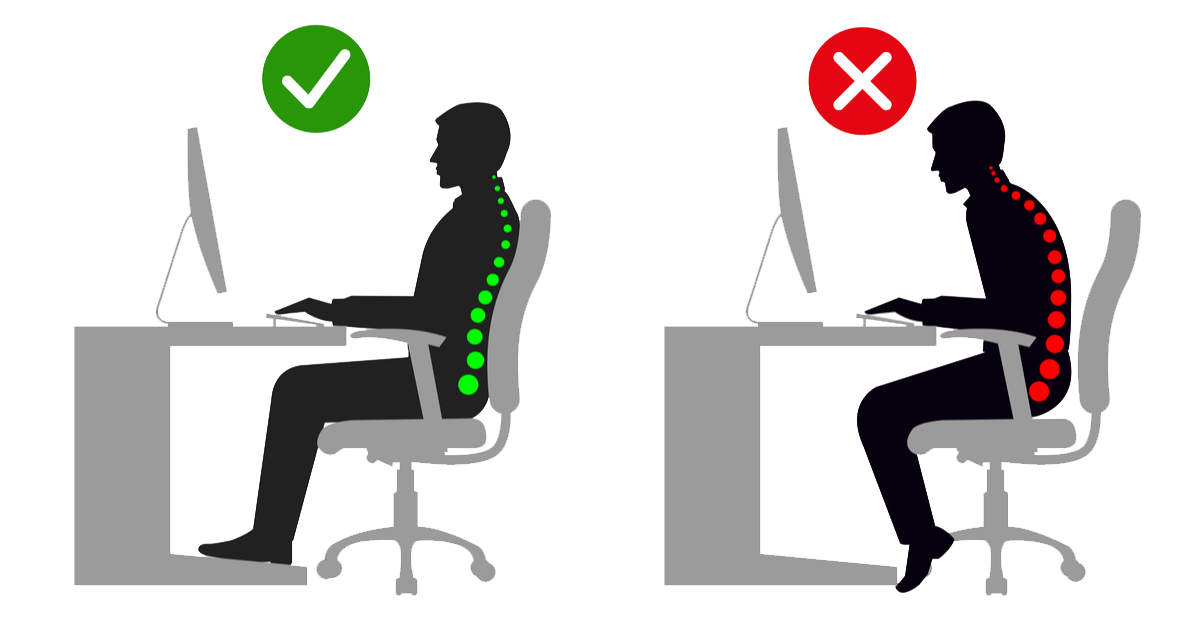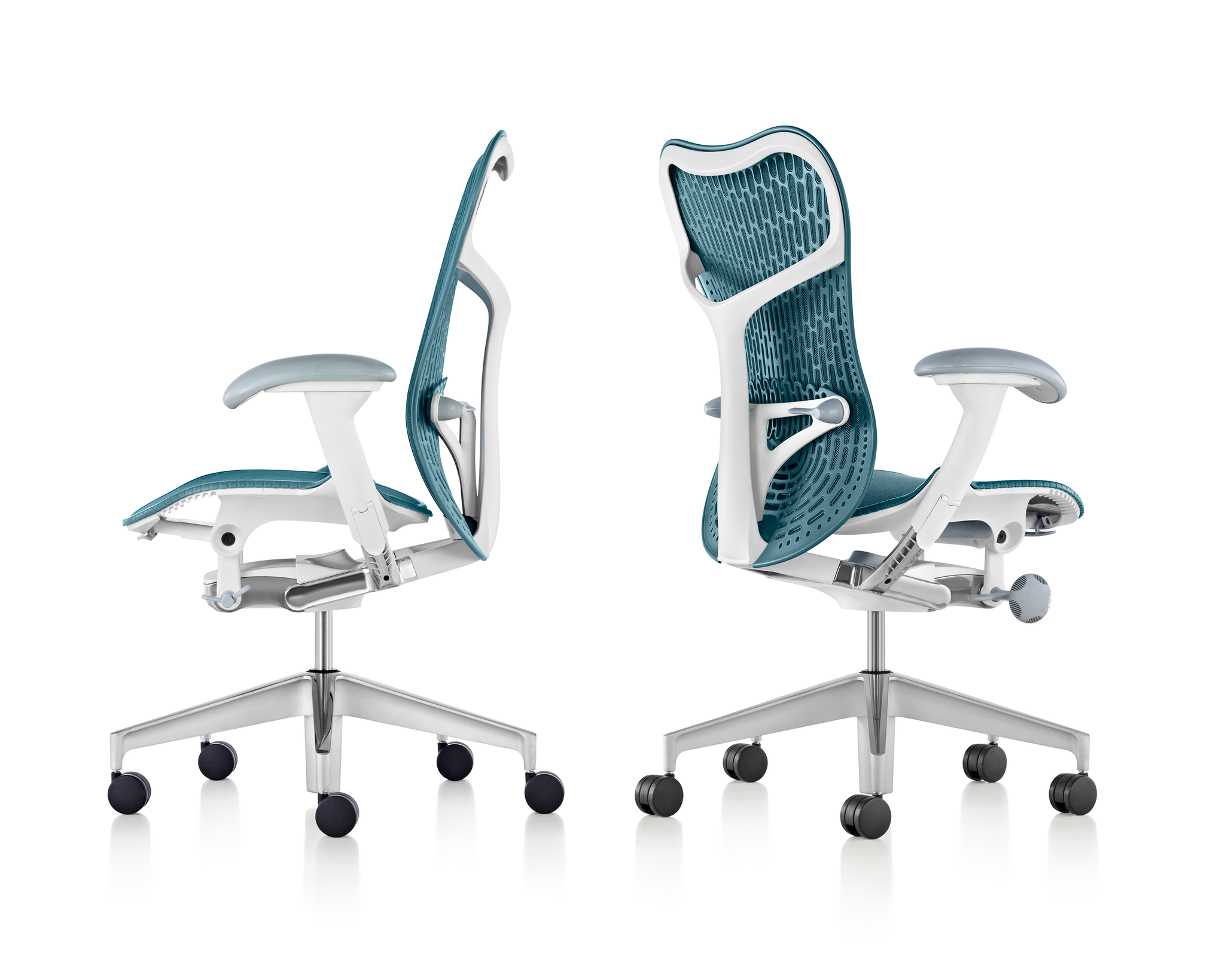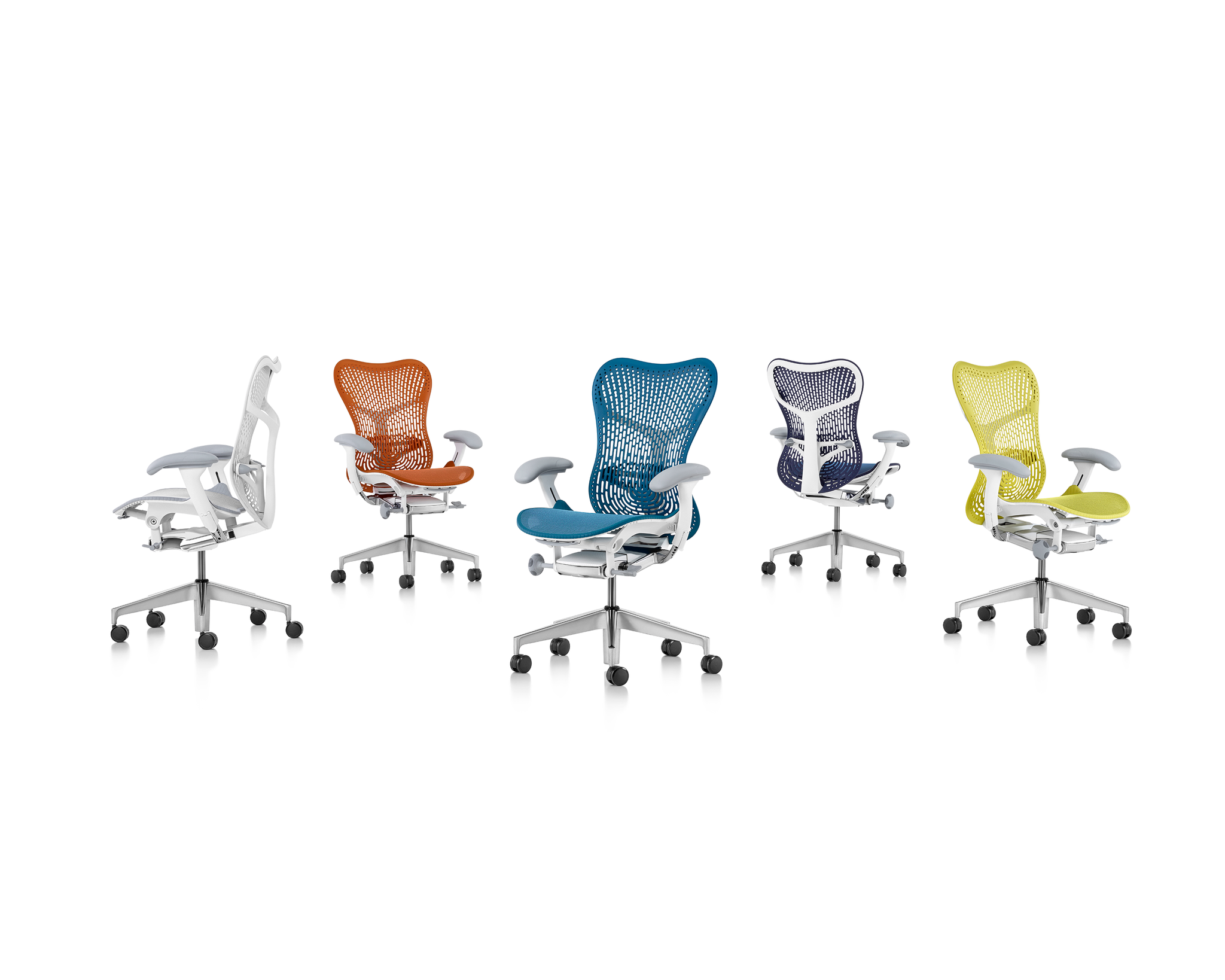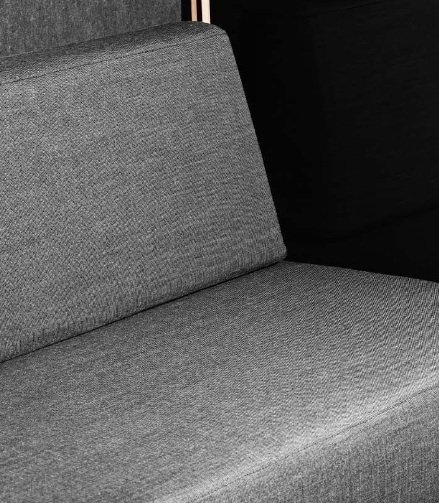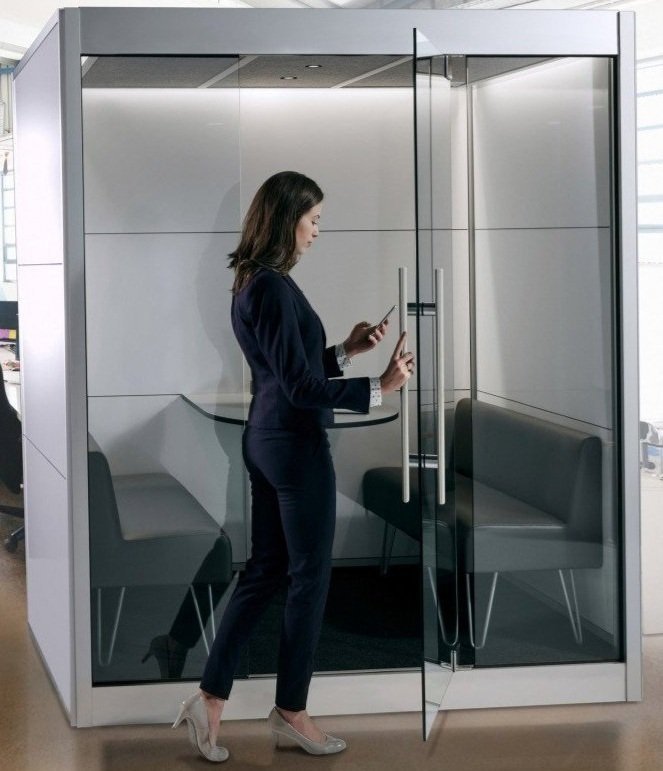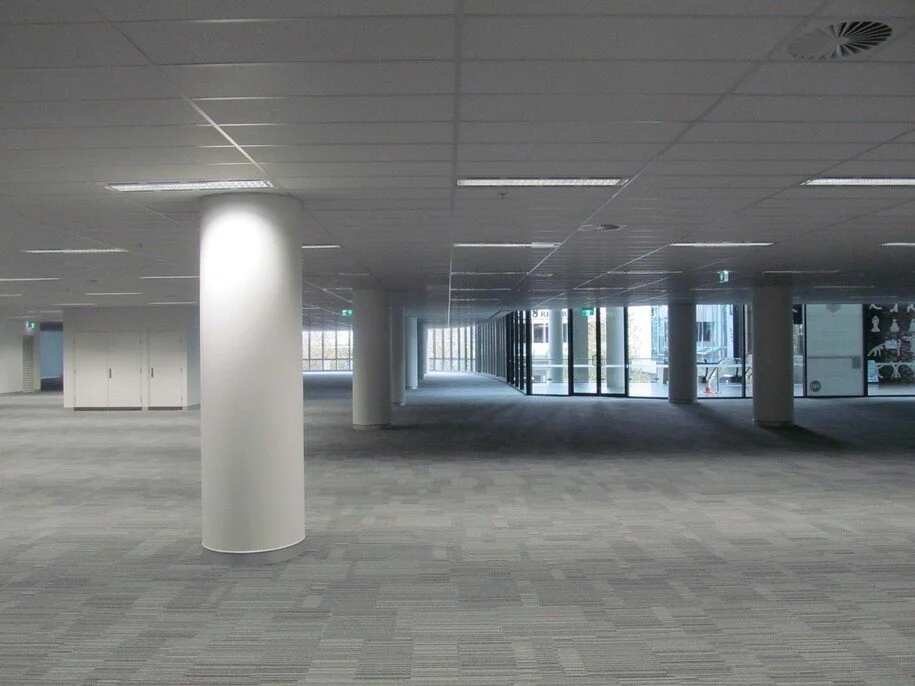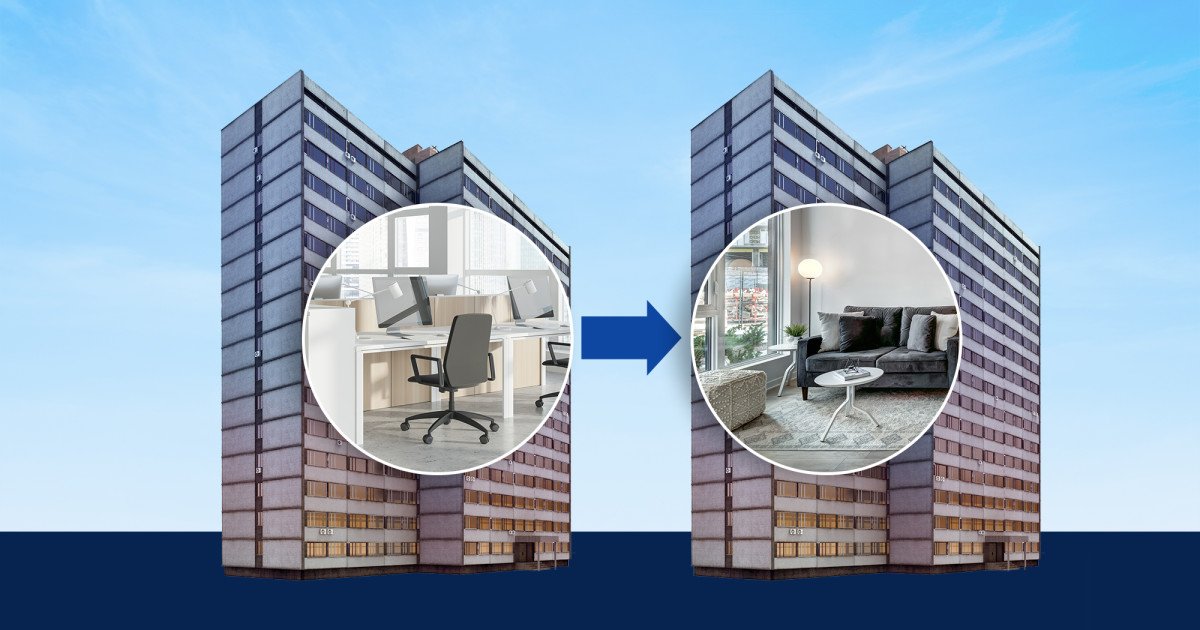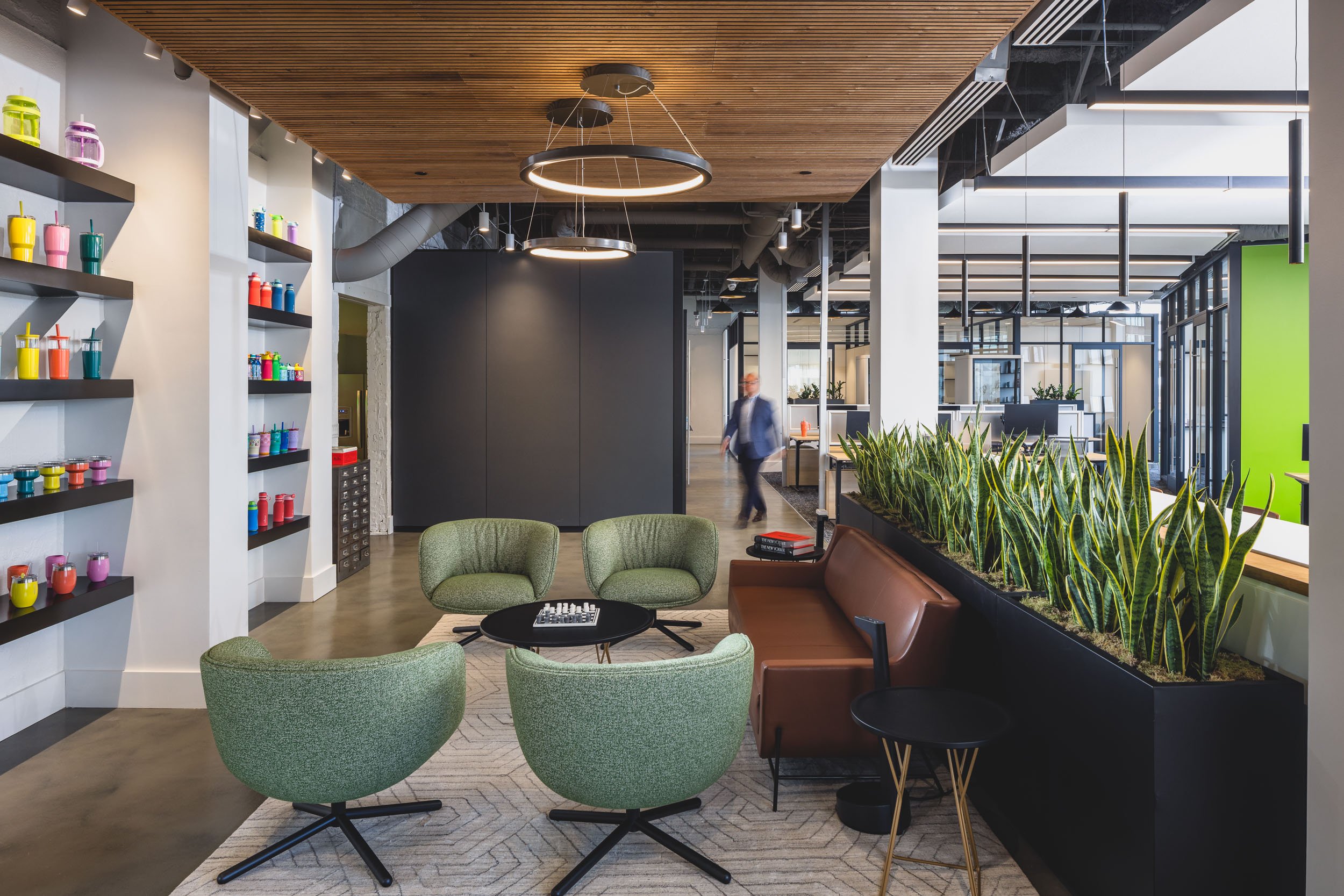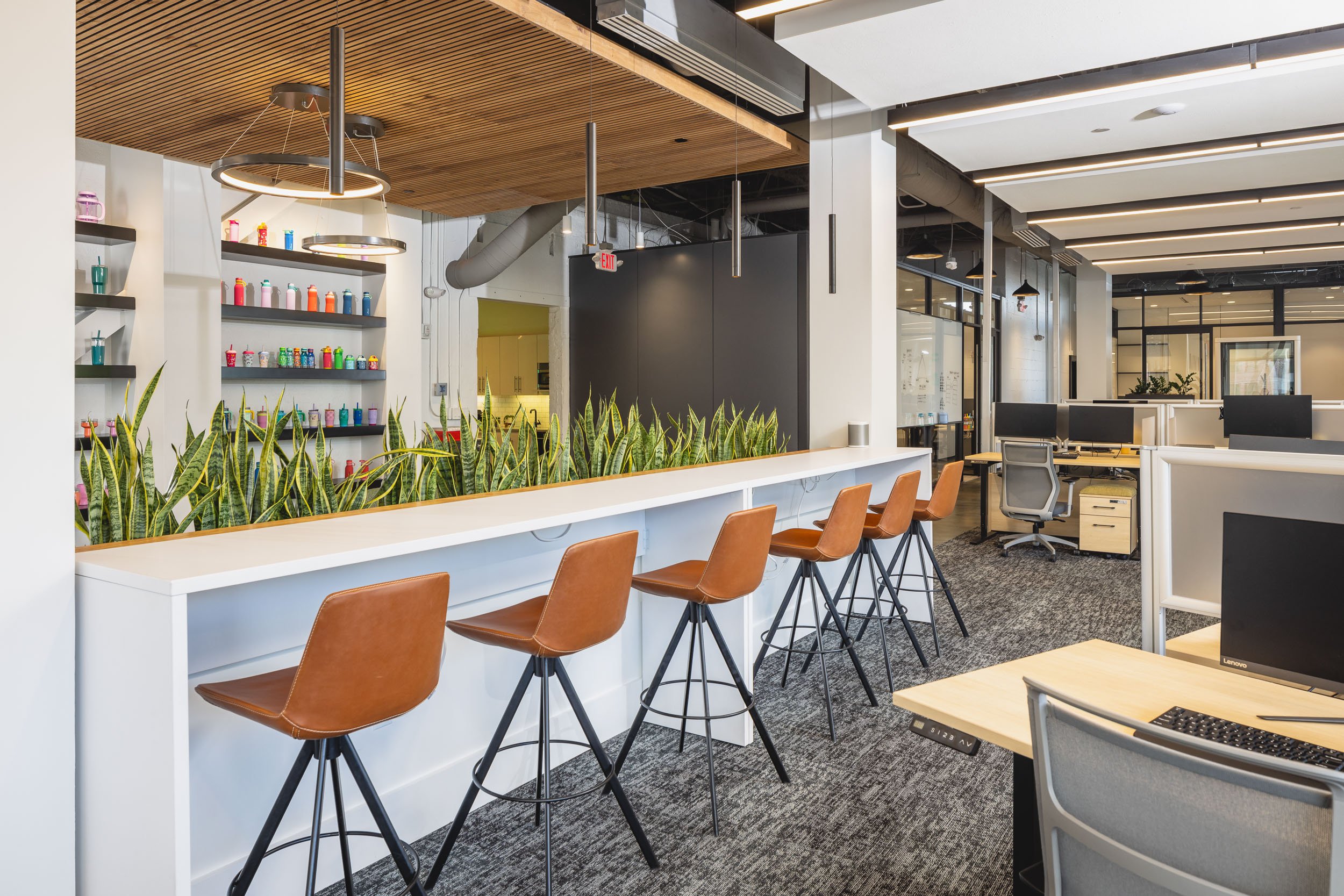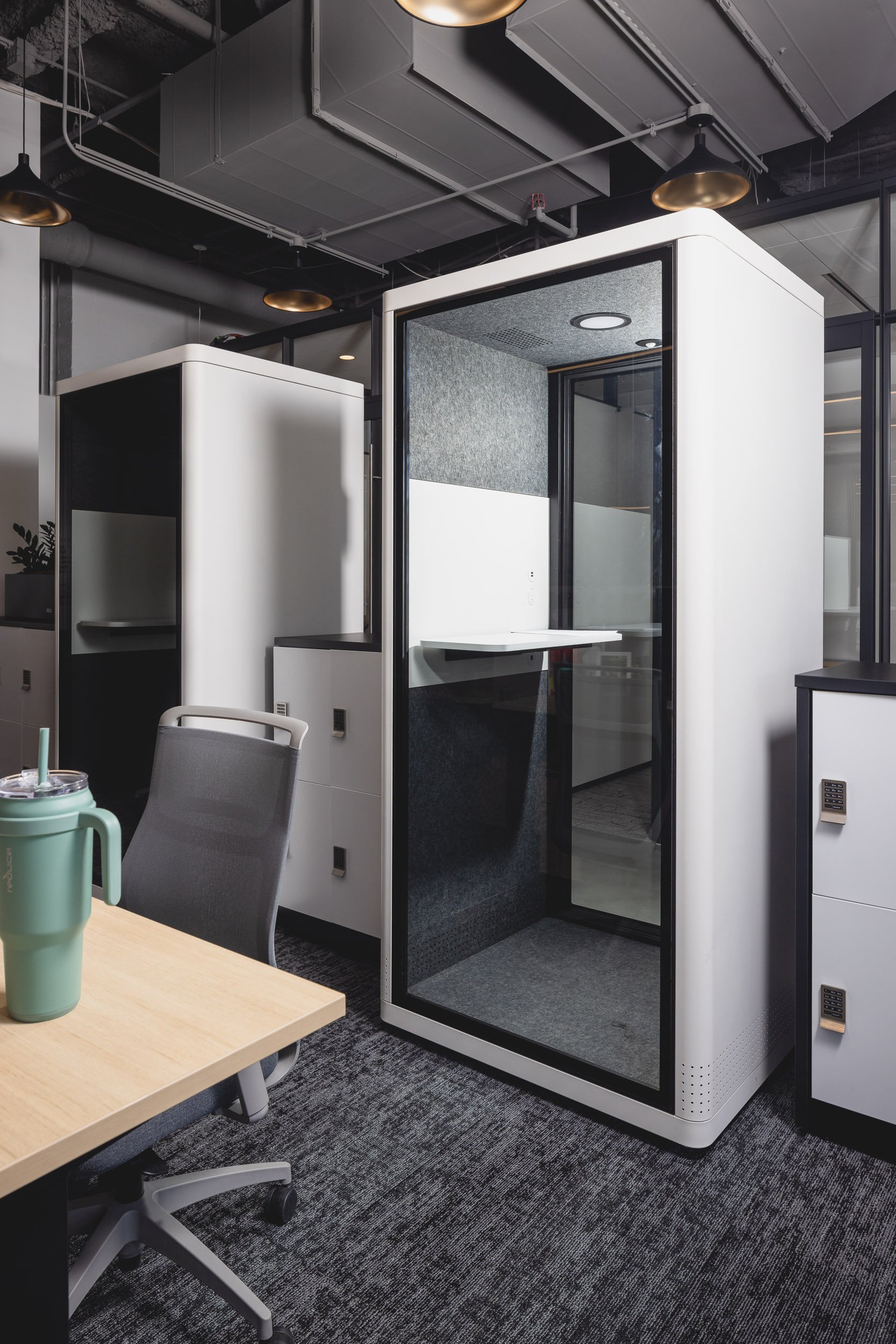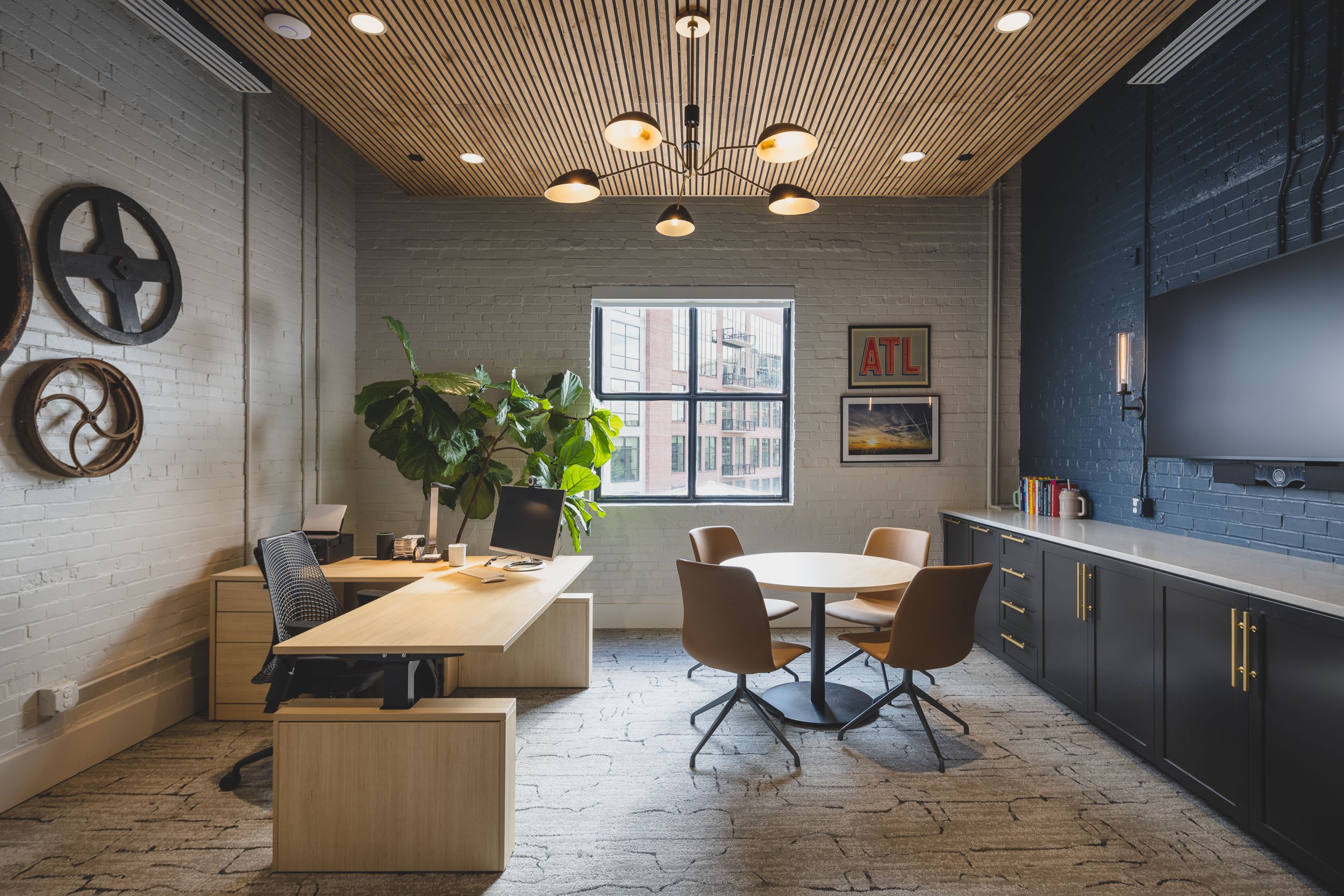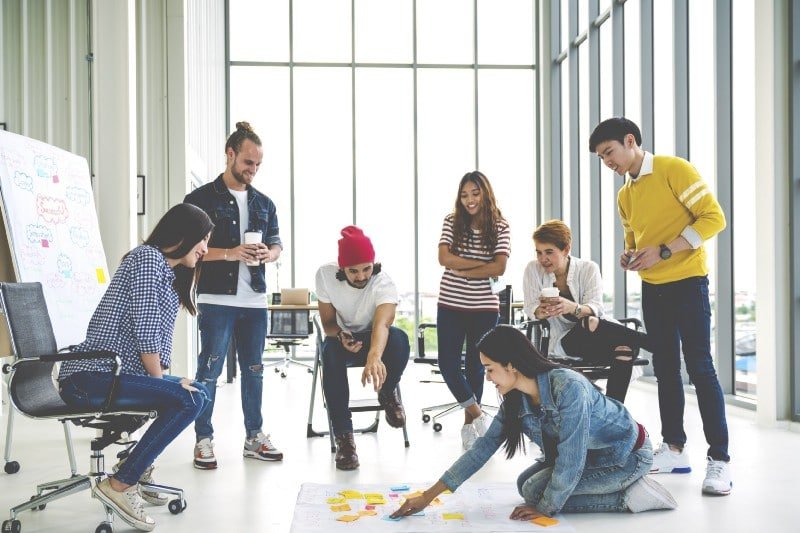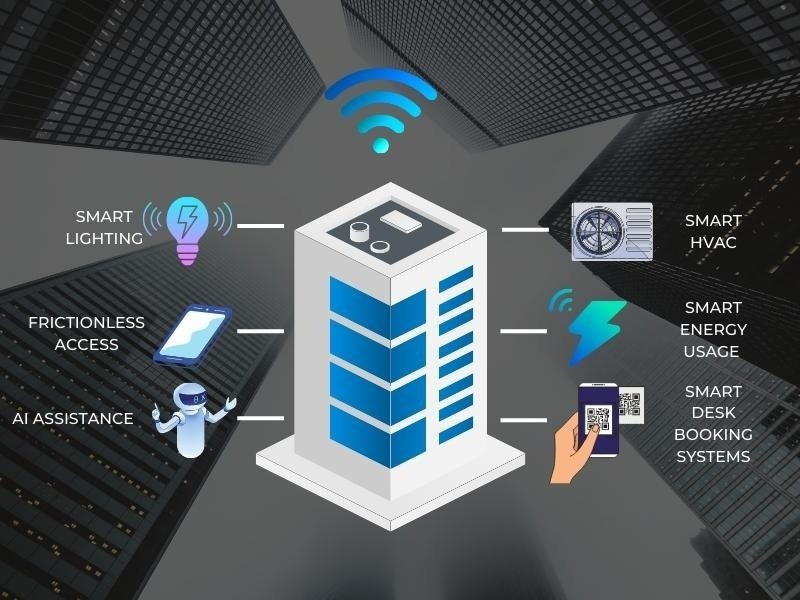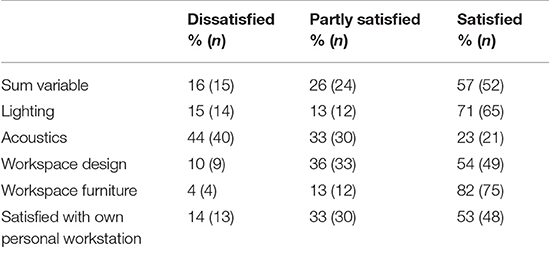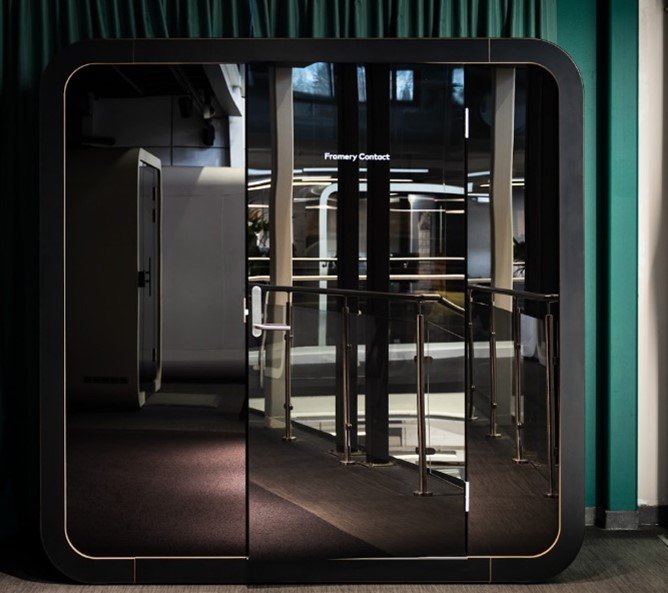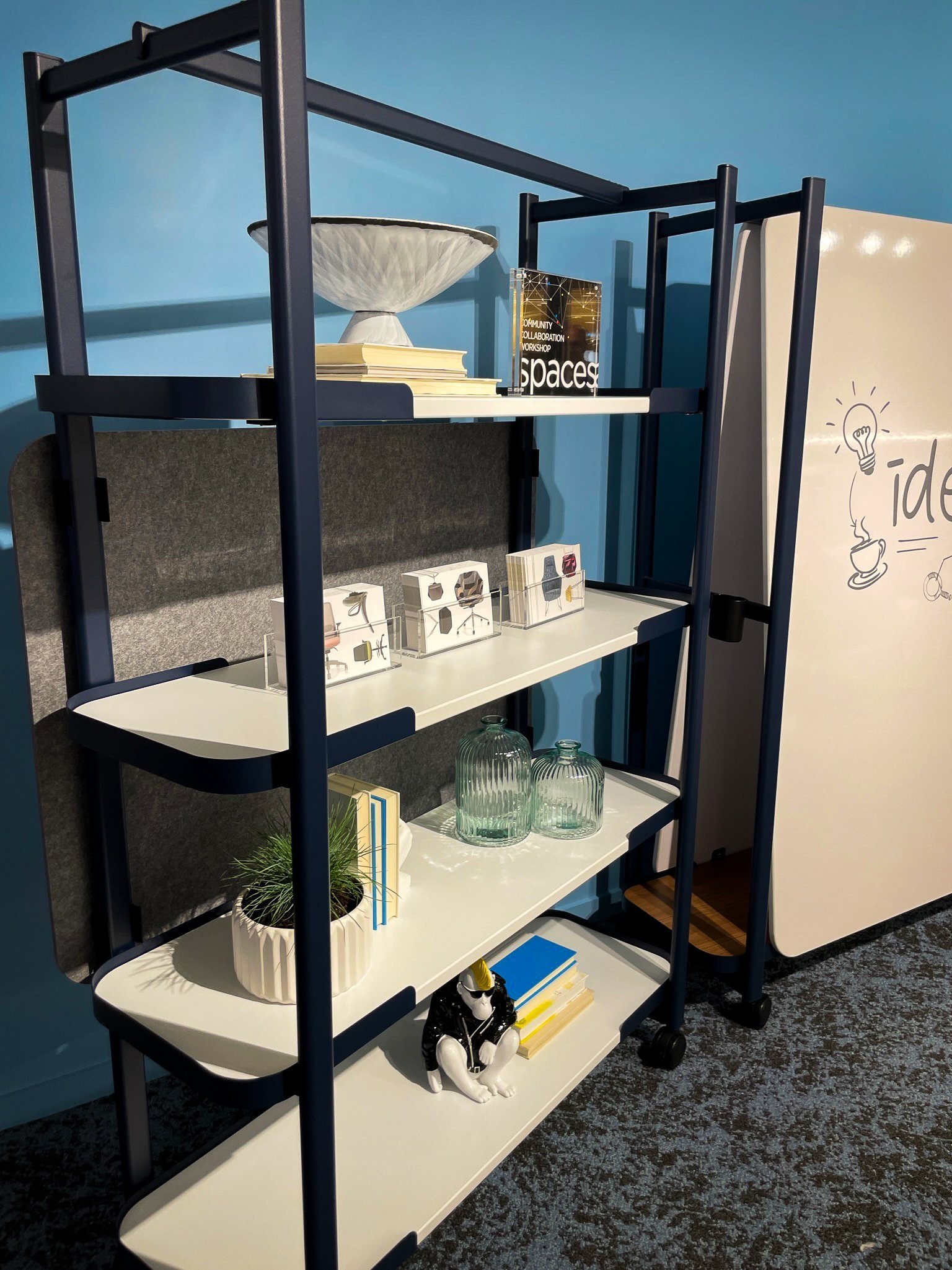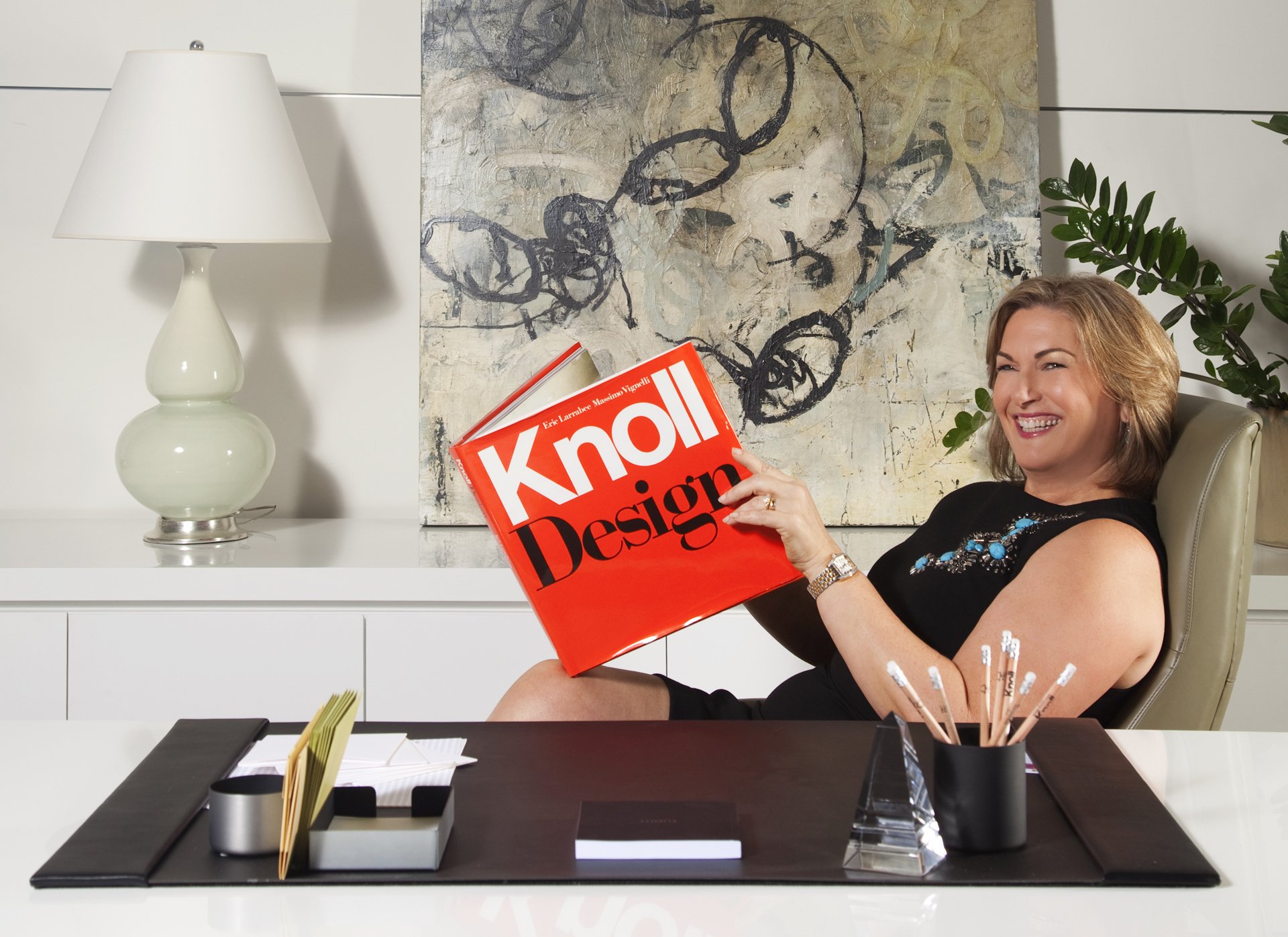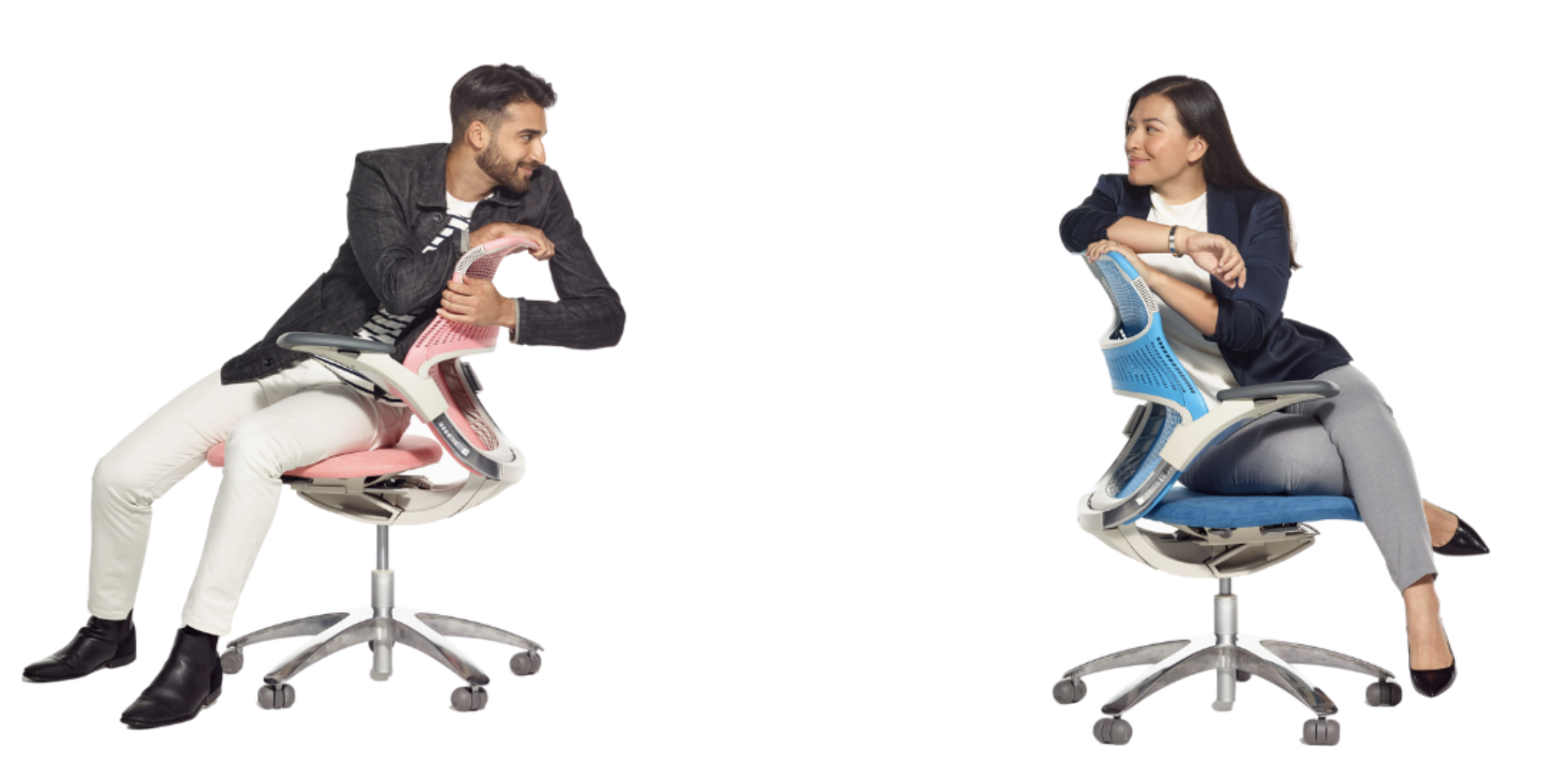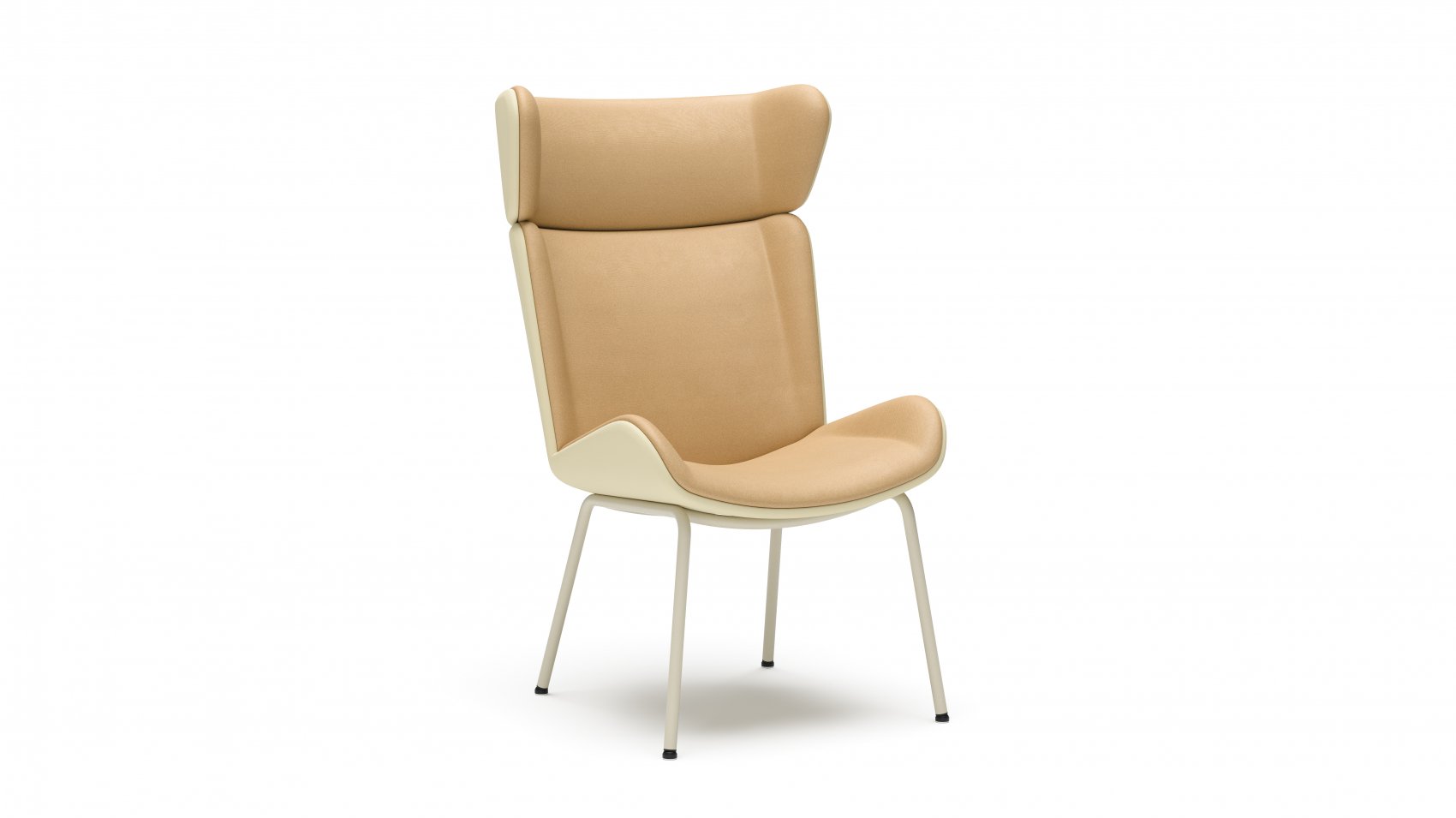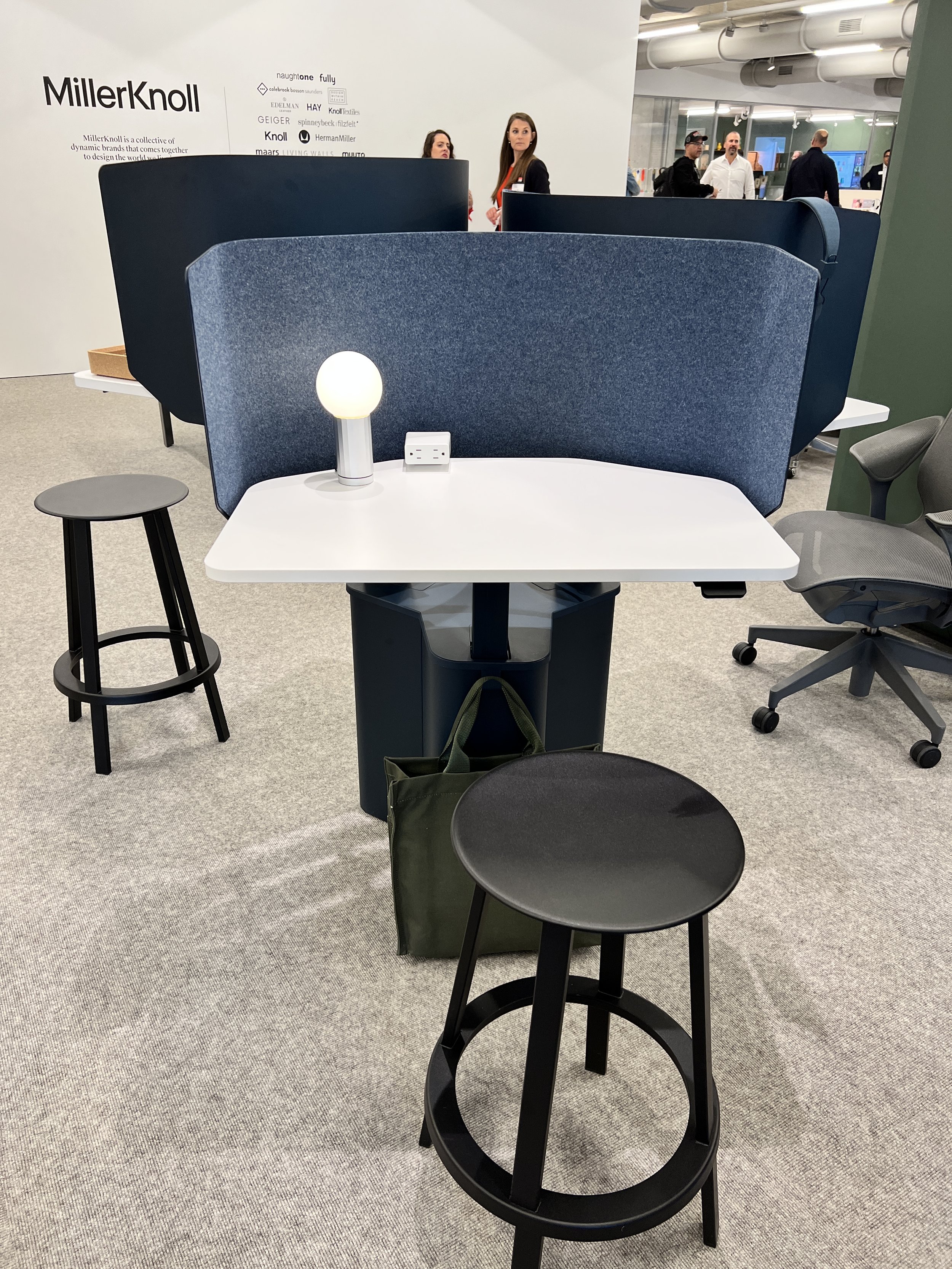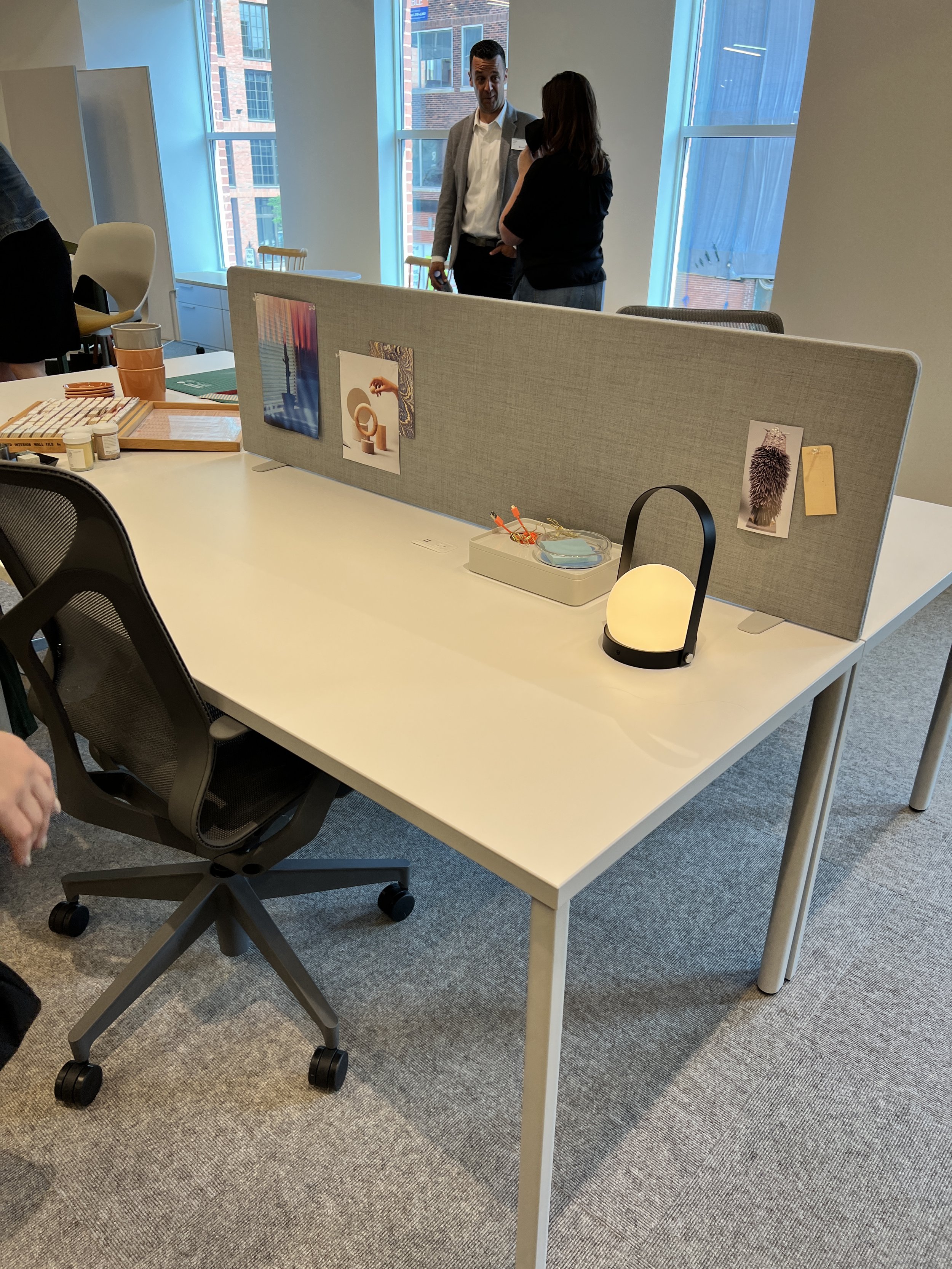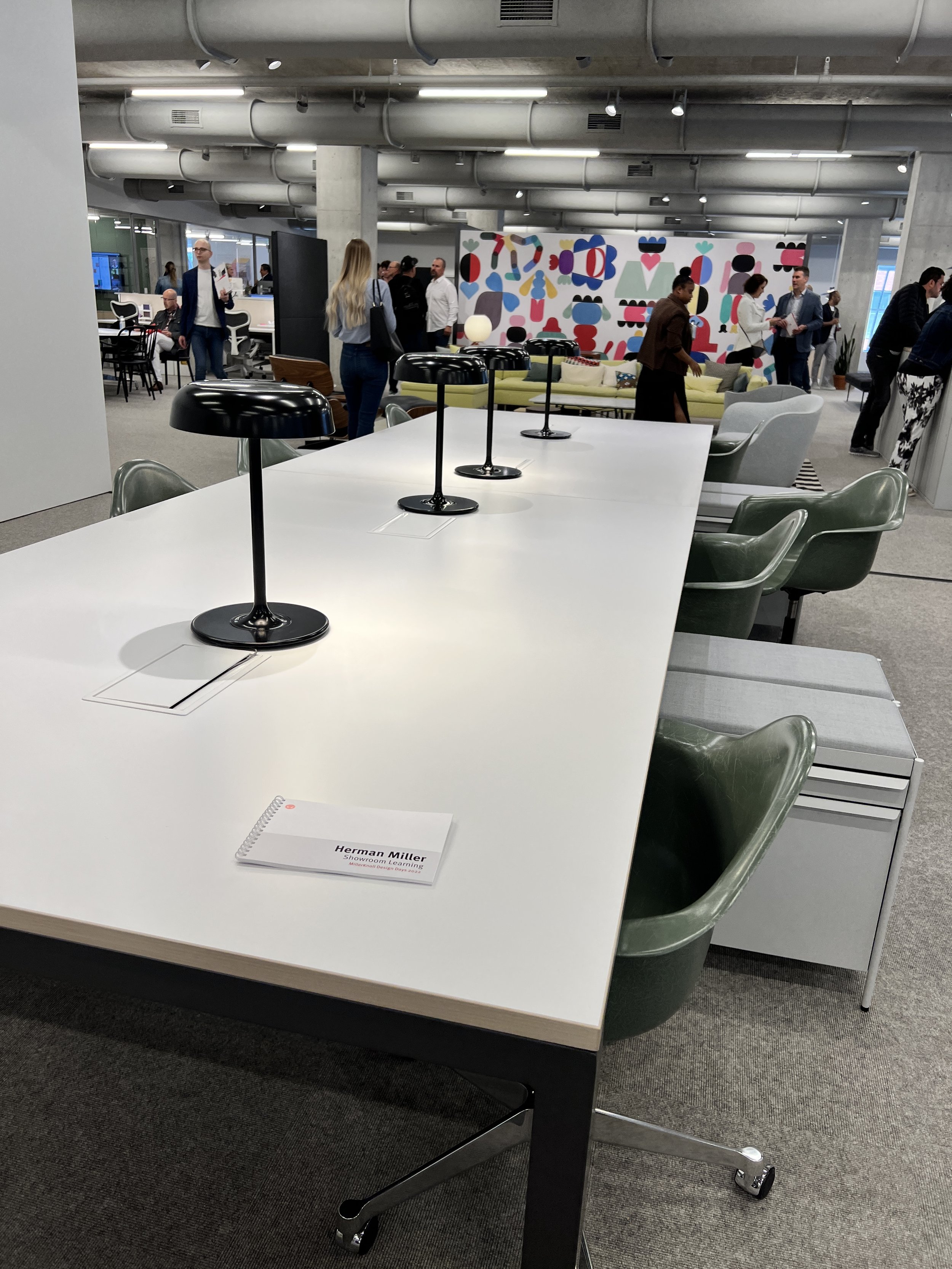The Green Revolution: Sustainable Design Trends in Commercial Interiors for 2024
Earth Day has been celebrated on April 22nd since 1970; it is a time to reflect on our impact on the environment and explore ways to embrace sustainability in every aspect of our lives. In the commercial design industry, 2024 is shifting towards more eco-conscious designs
Photo: Entertainment Tonight
Earth Day has been celebrated on April 22nd since 1970, it is a time to reflect on our impact on the environment and explore ways to embrace sustainability in every aspect of our lives. In the commercial design industry, 2024 is shifting towards more eco-conscious designs. According to the World Economic Forum, approximately 40% of solid waste in the United States comes from construction and demolition activities. As the demand for sustainable solutions grows, manufacturers are answering the call through eco-friendly, and efficient designs. Learn with us as we dive into some furniture manufacturers and how they are leading the charge in sustainable design for 2024:
1. Millerknoll:
A merger of two industry giants, Millerknoll combines Herman Miller's commitment to sustainability with Knoll's innovative design approach to improve both spaces and our planet. With products that prioritize both aesthetics and environmental responsibility, Millerknoll offers a diverse range of sustainable furniture solutions for work environments. When the collective of brands came together in 2021, they came with a different point of view all to make the future of design more sustainable for clients, the community, and the planet. MillerKnoll has taken the steps to do more for our planet by engaging the entire community in their sustainable practices such as eliminating plastic water bottles at all facilities reducing single-use plastic in packaging by 30% to and engaging in Maersk ECO delivery to replace fossil fuel with green fuel. The collective brands have designed products to be easily disassembled and recycled at the end of life. For example, the Ever Sofa by NaughtOne is the brand’s first upholstered product made to be easily disassembled and recycled at the end of life. The collective’s tradition of designing a greener world is evident as their 2030 goals continue to inspire more sustainably manufactured products such as Herman Miller’s Eames Molded Plastic Chair. As of 2022, the Eames Molded Plastic Chair is being made using 100% post-industrial recycled plastic.
2. Geiger:
Geiger, part of the MilerKnoll collective, specializes in high-quality wood furniture crafted with sustainability. With a focus on responsible forestry practices and minimal environmental impact, Geiger offers timeless designs that prioritize both aesthetics and eco-friendliness. Collaborating with the Environmental Protection Agency and its chemical suppliers, Geiger initiated the development of water-based top-coat materials in the mid-1990s. By 1998, they transitioned to water-based stains and sealants, making Geiger one of the pioneering furniture manufacturers globally to do so. This switch not only removed solvent-based materials and their associated VOCs from their processes, maintaining top-notch finishes for their products, placing Geiger on the path to becoming a leader in sustainable manufacturing.
3. DIRTT:
DIRTT stands out in sustainable construction and interior solutions in a big way. When your needs shift, DIRTT's adaptable system enables immediate, simple, and cost-efficient adjustments to your space, avoiding the need for demolition. By continually repurposing elements of your environment, you safeguard your investment, allowing for future reconfigurations and moves while minimizing landfill waste. DIRTT’s flexible system is engineered for disassembly, reducing the carbon footprint associated with both initial construction and subsequent modifications. With the multi-trade prefabrication construction system, your space is meticulously manufactured and pre-assembled at DIRTT's facilities, optimizing material usage, minimizing offcuts, dust, or waste, and ensuring a clean and efficient construction process.
4. Global:
Global is another industry leader in sustainable furniture design. When you think Global, think green. Global’s environmental commitment is seen throughout their manufacturing process. For example, eliminating the use of CFCs (Chlorofluorocarbons) and HCFCs (hydrochlorofluorocarbons) in all their manufacturing processes to protect the ozone layer. They utilize powder coat paint finishes, employing an electrostatic process that reclaims and reuses 99% of overspray without any solvents or CFCs. Of course, with the number of textiles used in our industry, Global is known to turn scrap into style with their partnership with Echoes in the Attic where they use textile scraps in their product designs from handbags to pillow designs, thus promoting reuse and restyling of fabrics. Global believes that they have a responsibility to protect the environment in all possible ways. Through their End-of-Life Program, they have been able to redirect their products to national/international programs for appropriate life cycle management instead of landfill disposal. Their product line not only prioritizes ergonomic functionality but also demonstrates environmental responsibility through a diverse array of eco-friendly offerings.
5. OFS:
OFS prioritizes sustainability, offering eco-conscious furniture solutions ideal for environmentally friendly commercial interiors. Their commitment to sustainable design is apparent in the introduction of two new fabrics, Allure and Roam, both made with Repreve recycled fiber. Each yard of Allure fabric incorporates 31 recycled bottles, while Roam contains 21 recycled bottles. OFS has also partnered with One Tree Planted to contribute to global reforestation efforts. Tree planting stands as the foremost solution to combatting climate change. Through this partnership, OFS can plant sufficient trees to counterbalance Greenhouse Gas emissions. These emissions encompass their building electricity and natural gas consumption, as well as transportation fuel usage for Styline and all company-owned vehicles.
As we celebrate Earth Month in April, it’s important to consider the environmental impact of our design choices. The shift towards sustainable design trends in commercial interiors for 2024 reflects a growing awareness of our responsibility to protect the planet. By choosing manufacturers like Millerknoll, DIRTT, Global, OFS, and Geiger, businesses can not only create aesthetically pleasing work environments but also contribute to a greener, more sustainable future. Let’s continue to prioritize sustainability in every aspect of our lives, starting with the spaces where we work and thrive.
These are only a highlight of the trends we’ve observed, what other trends are you seeing in sustainable design?
Celebrating the women who shaped the furniture industry
As we honor Women’s International Month, let us explore the lives and legacies of some of the most influential women in the furniture industry. From pioneers like Florence Knoll and Ray Eames to the trailblazers of today, their stories remind us of the power of perseverance, creativity, and determination in shaping the world around us.
Photo: Entertainment Tonight
International Women’s Month has finally kicked off! As we embark on this month-long celebration of women’s achievements and contributions, we are reminded of the incredible accomplishments made by women in the furniture design industry. Corporate Environments and MillerKnoll have been nurtured by the dedication and vision of women like Karen Hughes and Andi Owen. Their efforts and commitment to excellence have pushed our organizations forward, inspiring others along the way.
As we honor Women’s International Month, let us explore the lives and legacies of some of the most influential women in the furniture industry. From pioneers like Florence Knoll and Ray Eames to the trailblazers of today, their stories remind us of the power of perseverance, creativity, and determination in shaping the world around us.
The women behind Millerknoll:
FLORENCE KNOLL
Florence Knoll, an iconic figure in the world of furniture design, was not only a visionary designer but also an entrepreneur. As the driving force behind the renowned furniture company Knoll Inc., Florence played a pivotal role in shaping the modern landscape of interior design. With her keen eye for aesthetics and functionality, she revolutionized the concept of office furniture, introducing sleek, minimalist designs that emphasized both form and function.
Knoll's approach to design, characterized by clean lines, geometric shapes, and a harmonious blend of materials, set a new standard for modern furniture that continues to influence designers to this day. Her commitment to quality craftsmanship and attention to detail ensured that each piece exhibited elegance and sophistication.
Office Concept Sketch by Florence Knoll
Beyond her contributions to furniture design, Florence Knoll paved the way for women to assume leadership roles in the male-dominated field of design and architecture. Her legacy serves as an inspiration to aspiring designers everywhere, reminding us that with talent, perseverance, and determination, anything is possible.
To learn more, click Florence Knoll
RAY EAMES
Ray Eames, along with her husband Charles, formed one of the most iconic design duos of the 20th century. Together, they created some of the most influential furniture designs of their time, leaving a lasting mark on the world of modern design.
As a multifaceted artist, Ray Eames brought her unique perspective and creative vision to every project she undertook. Her playful yet sophisticated approach to design, characterized by bold colors, organic forms, and innovative use of materials, helped redefine the aesthetic of mid-century modernism. From the iconic Eames Lounge Chair to the innovative molded plywood furniture, Ray Eames' designs exemplified innovation and experimentation of the mid-century modern era.
Her ability to seamlessly blend art and functionality resulted in furniture that was not only visually striking but also comfortable and practical, making it accessible to a wide audience.Ray Eames' influence extends far beyond the realm of furniture design, encompassing architecture, filmmaking, and graphic design. Her spirit and creativity continue to inspire designers and artists around the world, proving that true innovation knows no bounds.
To learn more, click here Ray Eames
As we celebrate International Women’s Month, let us pay tribute to these extraordinary women and the countless others who have made invaluable contributions to the furniture industry. Their creativity, ingenuity, and passion have not only shaped the way we live and work but have also enriched our lives in ways we may never fully realize. Here's to the visionaries, and the pioneers who continue to inspire us with their timeless designs and enduring legacies.
We know that you all have a favorite designer that has impacted you so we want to know, who are your heros that you celebrate for International Women’s Month? Let us know in the comments!
Harmonizing Productivity: Harnessing Acoustics in the Workplace
The role of acoustics in the workplace is important. Excessive noise can serve as a daily obstacle, hindering concentration, disrupting workflow, and ultimately impacting job satisfaction. Whether it's the bustling chatter of colleagues, the continuous ring of phones, or the persistent ticking of the clock, unwanted noise can significantly slow down productivity
It's 3 o'clock, and the day feels like it's crawling along at a snail's pace. You find yourself immersed in putting the final touches on your project, but the surrounding noise makes it feel like an uphill battle. John's phone call with his wife echoes through the room, while Max's continuously buzzing phone adds to the noise. Sarah, seated beside you, murmurs softly to herself as she reads through her emails. A never-ending ticking sound surrounds you, but nowhere to go to drown out the noise.
In today's ever-evolving work landscape, the traditional 9-5 work model is undergoing a significant transformation. With companies determined to strike a balance between bringing employees back to the office and attracting top talent, the focus has shifted towards creating environments that prioritize both productivity and well-being. This paradigm shift needs the integration of collaborative spaces, individual workstations, and thoughtful acoustic designs to achieve both. Acoustic design, furniture placement, the addition of carpets/rugs, biophilia all go hand in hand to minimize distractions, reduce stress levels, and mitigate sound distortion to appease neurodiverse employees.
The role of acoustics in the workplace is important. Excessive noise can serve as a daily obstacle, hindering concentration, disrupting workflow, and ultimately impacting job satisfaction. Whether it's the bustling chatter of colleagues, the continuous ring of phones, or the persistent ticking of the clock, unwanted noise can significantly slow down productivity.
Companies like Turf and Buzzispace have emerged as pioneers in providing innovative solutions to address these challenges. Turf's acoustic panels and partitions are meticulously engineered to absorb sound, reduce echo, and mitigate noise pollution facilitating an environment conducive to focus and engagement throughout the workday.
Similarly, BuzziSpace offers a diverse range of acoustic furniture, including sound-absorbing chairs, booths, and pods, which not only serve as stylish additions to the office but also provide functional solutions for creating quiet zones within the workspace.
By incorporating Turf Acoustic Solutions and BuzziSpace solutions into office design, companies can cultivate a more balanced work environment that supports collaboration, concentration, and creativity. These investments not only enhance productivity but also foster a sense of comfort and well-being among employees, serving to the neurodiverse group.
Prioritizing acoustic design empowers organizations to create a more encouraging work environment that nurtures employee well-being and performance. This includes sound-absorbing materials, thoughtful layout configurations, and the integration of technologies such as white noise machines or sound masking systems to minimize distractions and cultivate a quieter workspace.
Acoustics play a pivotal role in shaping the ambiance of the workplace. By addressing the challenges of noise and sound control, companies can pave the way for quieter, more productive work environments that promote employee and company success.
Corporate Environments was tasked with designing the Office of the Future at the Warner Robins Air Force Base; when doing so, it encountered a significant obstacle: the space featured high ceilings, which posed a challenge for managing sound levels effectively. By leveraging their knowledge and experience, they set out to implement tailored solutions that would harmonize productivity with the unique architectural features of the space.
The successful completion of the Office of the Future project at Robins Air Force Base underscored the transformative power of acoustics in shaping the modern workplace. Through design solutions and a commitment to excellence, Corporate Environments and MPS Acoustics demonstrated their ability to overcome challenges and deliver innovative acoustics optimized for productivity and well-being. As organizations continue to prioritize the creation of conducive workspaces, the role of acoustics will remain indispensable in unlocking the full potential of their workforce.
Contact us today to revolutionize your work environment!
Workplace Well-Being: Building a Supportive environment for Employees
As we continue celebrating Mental Health Awareness this month, the focus is on well-being, especially in the workplace. Explore how the workplace can contribute to and enhance employee well-being.
As we continue celebrating Mental Health Awareness this month, the focus is on well-being, especially in the workplace. This year, the conversation around well-being has and will continue to gain momentum as organizations recognize the impact of physical spaces on employee fulfillment.
The terms "wellness" and "well-being" are often used interchangeably. However, there's a difference. While wellness focuses on physical health, well-being is emotional, mental, social, and state of being. Understanding this distinction is important in designing strategies to support employees better. Explore how the workplace can contribute to and enhance employee well-being.
1. Emotional Well-Being: Fostering a Positive Atmosphere
Emotional well-being involves understanding and managing emotions. In the workplace, creating a positive atmosphere through open communication, recognition programs, and emotional support systems can contribute to the emotional well-being of employees.
2. Mental Well-Being: Embracing Individual Differences
Mental well-being goes beyond mental health issues. To support mental well-being, workplaces should embrace the differences in how individuals process sensory signals. (For more on this, check out our post: Embracing Neurodiversity) Providing mental health resources, destigmatizing mental health discussions, and offering flexibility can positively impact employees' mental well-being.
3. Social Well-Being: Cultivating a Connected Community
Social well-being is supported through positive interactions and a sense of community. The workplace can support social well-being by fostering a collaborative environment, organizing team-building activities, and promoting inclusivity. These initiatives contribute to a sense of belonging and social connectedness. At Corporate Environments, community and inclusivity are at the forefront of our organization. This month, the Spirit Committee planned a Vision Board Party for employees to participate in together to bring their visions to life by allowing a time to just enjoy being together, decompress, manifest, and set the stage on a positive note for the year.
4. State of Being: Designing Physical Spaces with Purpose
Designing physical spaces with purpose involves considering factors like lighting, ergonomic furniture, and comfortable break areas to allow employees various settings. A thoughtfully designed workplace can positively influence the overall state of being, contributing to a balanced work environment.
To support employees’ well-being, workplaces must take intentional steps. This includes providing resources for mental health, offering flexible work arrangements, fostering a culture that prioritizes emotional support, and creating a physically encouraging environment. Recognizing and addressing the diverse needs of employees creates a more inclusive and supportive workplace.
When fostering employee well-being, understanding the differences between wellness and well-being is key. The workplace, as a significant part of our daily lives, has the potential to either enhance or hinder well-being. By prioritizing emotional, mental, social, and overall state of being, and designing physical spaces with purpose, organizations can contribute to a positive and supportive environment that promotes employee well-being in 2024 and beyond.
Ready to transform your workplace into a thriving hub of well-being and productivity? Contact us today!
7 Workplace Trends for 2024: Take a look at what’s in.
As we step into 2024, new trends are set to redefine the way we work, collaborate, and innovate.
In the ever-evolving workplace landscape, staying ahead of the curve is essential for businesses to thrive. This year's trend is for organizations to focus more on how the office can support employee needs rather than the number of employees working there. As we enter 2024, new trends are set to redefine how we work, collaborate, and innovate.
Here are the 7 rising workplace trends to look for in 2024:
1. In: Flexibility and adaptability in workspaces. | Out: Traditional, rigid 9-to-5 office structures.
The workplace has long been changed since the pandemic. Now, employees have the freedom to choose to work in or out of the office in search of spaces that support their needs, from quiet spaces to collaborative and technology-friendly spaces. The hybrid work model is here to stay in 2024, but many will continue to push for in-person experiences to make it worth the commute and build company culture where people can learn, grow, and feel accomplished. These spaces are needed more than ever now, ensuring a work environment that caters to the varied preferences and requirements of all employees. It’s a matter of how employers can provide an adaptable workspace for all.
2. In: Integration of VR/AR for immersive meetings. | Out: Conventional video conferencing tools.
The integration of VR and AR for immersive meetings will continue to rise in workplace settings to enhance team collaboration, brainstorming sessions, and shared virtual workspaces. The ability to create these immersive experiences is not only helpful to designers but also helps with onboarding new hires, training opportunities, providing virtual tours to international clients, and optimizing 3D models to present all angles.
3. In: Well-being programs addressing mental health. | Out: Neglecting mental health and overall well-being.
It is important to destigmatize mental health in the workplace and promote a culture that encourages open conversations, support systems, and clear access to professional resources. A supportive work environment contributes to the overall well-being of employees. Happier employees make a happier work experience and collectively get work done. The workplace is not just about having an onsite gym but more about creating spaces to connect, recharge, and have an overall positive impact on employees.
4. In: Eco-friendly office spaces and sustainable business practices. | Out: Indifference towards environmental impact.
As it remains prevalent in today’s climate, sustainable design is no longer an option but an obligation to our planet, and it starts with us - designing workspaces with sustainability at the forefront. The workplace of the future starts with not only smart technology but also pushing for sustainable design resources to increase the quality of our global community. Sustainability doesn’t always mean eco-friendly furniture but prioritizing natural lighting, pushing recycling initiatives, natural ventilation, and effective heating control systems. There is so much office spaces can do to better support eco-friendly business practices, from selecting materials produced with minimal emissions and eco-friendly materials to implementing reduce, reuse, and recycle strategies within the company culture, and much more.
5. In: AI-powered tools | Out: Manual, time-consuming processes without AI integration.
As the rise of AI resources is becoming a focus in today’s workplace, 2024 will be the year many companies will start to push out tools to reduce the time spent on tasks and increase available time to focus on strategic planning and the company's success. These AI-powered tools will be common as companies move towards a more efficient way to organize and analyze data, generate content, and automate simple daily tasks. This wave of new AI technology was only available to a niche industry, now every organization has some level of access to an AI tool to better improve work quality in less time and at a lower cost.
6. In: Continuous learning programs for skill development. | Out: Static skill sets with no emphasis on ongoing learning.
In today’s evolving professional world, the static skill set is becoming more outdated, and many organizations are focusing on providing workspaces that encourage continuous learning programs for individuals to expand their knowledge, enhance their professional growth and increase overall job satisfaction. Promoting a learning environment ensures that employees stay relevant in this rapidly evolving job market and helps employers retain top talent by prioritizing their personal and professional growth.
7. In: Creating diverse and inclusive environments. | Out: One size fits all
Providing practical strategies to foster inclusivity from hiring practices, diversity training, and creating groups to support employees of all backgrounds is a non-negotiable for 2024. It is important that organizations are actively working towards diversity and inclusion to create a workspace where every individual feels valued, included and supported.
The commercial workplace of 2024 is set to be a dynamic and innovative space, driven by what's in and what's out. By embracing the trends that are shaping the future and leaving behind outdated practices, businesses can create work environments that inspire creativity, collaboration, and success. As we navigate the evolving landscape, the key lies in adaptability and a forward-thinking approach to ensure a thriving commercial workplace that is focused more on the people who utilize it everyday.
SIT SMART, WORK WELL: 4 BENEFITS OF AN ERGONOMIC CHAIR YOU CAN’T IGNORE
Melissa, a designer at a local design firm in Atlanta, has been working at the firm for almost 2 years. At only 24 years old, she finds herself scheduling a few too many chiropractic appointments for someone who considers themselves a healthy person. One evening, as she plugged away on a project, Melissa caught herself constantly readjusting in her office chair.
Melissa, a designer at a local design firm in Atlanta, has been working at the firm for almost 2 years. At only 24 years old, she finds herself scheduling a few too many chiropractic appointments for someone who considers themselves a healthy person. One evening, as she plugged away on a project, Melissa caught herself constantly readjusting in her office chair. A moment of self-awareness struck her as she realized the discomfort she was experiencing. Her chair was the culprit. Whether you find yourself working in a home office, a flexible coworking space, or your favorite Starbucks, the common denominator here is sitting.
While the act of sitting may seem straightforward, it involves a complex interaction of bones, muscles, tendons, joints, and nerves. Even when we “sit still” our bodies are constantly moving. So, while the act of sitting is natural, maintaining one seated position for a long time (like the traditional office task position) is not. When we sit in forward leaning positions we place a massive stress on our bodies, particularly the lumbar area of the back and spine - (sound familiar?)
So why question the chair you’re sitting in? What sets a better office chair apart from the ones readily available on Amazon? The answer lies in the term "ergonomic," a buzzword that has been steadily gaining traction in the commercial furniture industry. In short, ergonomics is the study of people in their working environment. An ergonomic chair is designed with the explicit goal of removing discomfort and promoting optimal well-being.
In a world where the consequences of sedentary work are increasingly evident, an ergonomic chair serves as more than just a comfortable seat. It becomes a proactive measure to protect against the toll of prolonged sitting, offering a solution to the physical strain that many, like Melissa, experience. As conversations about ergonomic practices grow, picking your workplace office chair isn't just about convenience—it's a commitment to your employees' health.
Consider these top four features in the DNA of an ergonomic chair when contemplating your next seating choice:
1. Natural Balanced Movement:
An ergonomic chair is designed to promote natural and balanced movement while seated. Traditional chairs may force the body into fixed positions, leading to discomfort and stiffness. The Mirra 2 chair strikes a delicate balance between support and flexibility. Its Butterfly Back design ensures optimal spinal support, while the flexible seat and back adapt harmoniously to the user's movements. Reflecting Millerknoll's commitment to sustainability, the Mirra 2 is also an environmentally conscious choice for conscientious workplaces. Building on its past as the first office chair made with the environment in mind, Mirra 2 keeps the eco-friendly design going by using and reusing materials better. When redesigning Mirra, Studio 7.5's rule was simple: "every molecule counts."
2. Total Spinal Support
Designed with the natural curve of the spine in mind, this support helps prevent slouching, minimizes the strain on the lower back, and reduces the risk of developing back pain. Millerknoll's Embody Chair stands at the forefront of ergonomic innovation. Its pixelated support system adapts dynamically to the user's movements, promoting healthy posture and minimizing discomfort. It is known for pressure distribution, natural alignment, and support for healthy movement.
3. Dynamic Fit:
Ergonomic chairs are designed to support you through all your twists and turns, no matter the shape or size of your body. For example, the Aeron chair, an enduring symbol of ergonomic excellence, has evolved with the times under the Millerknoll banner originating in 1994. Having a breathable mesh design and customizable adjustments, the Aeron chair provides unparalleled lumbar support for a wide range of body types. For more than 30 years, MillerKnoll has been perfecting Aeron so that it’s good for your body as well as for the environment. It’s the chair that moves forward.
4. Flexible to use in different settings:
From comfort during group settings, to dedicated workstations, the chair accommodates sitting styles and postures with little to no adjustment to provide support for both short and long-term sitting. The Generation chair is designed to cater to the needs of modern, dynamic workstyles. With its adaptive flex back and intuitive adjustments, the Generation chair supports natural movement, empowering users to stay comfortable and engaged throughout their workday.
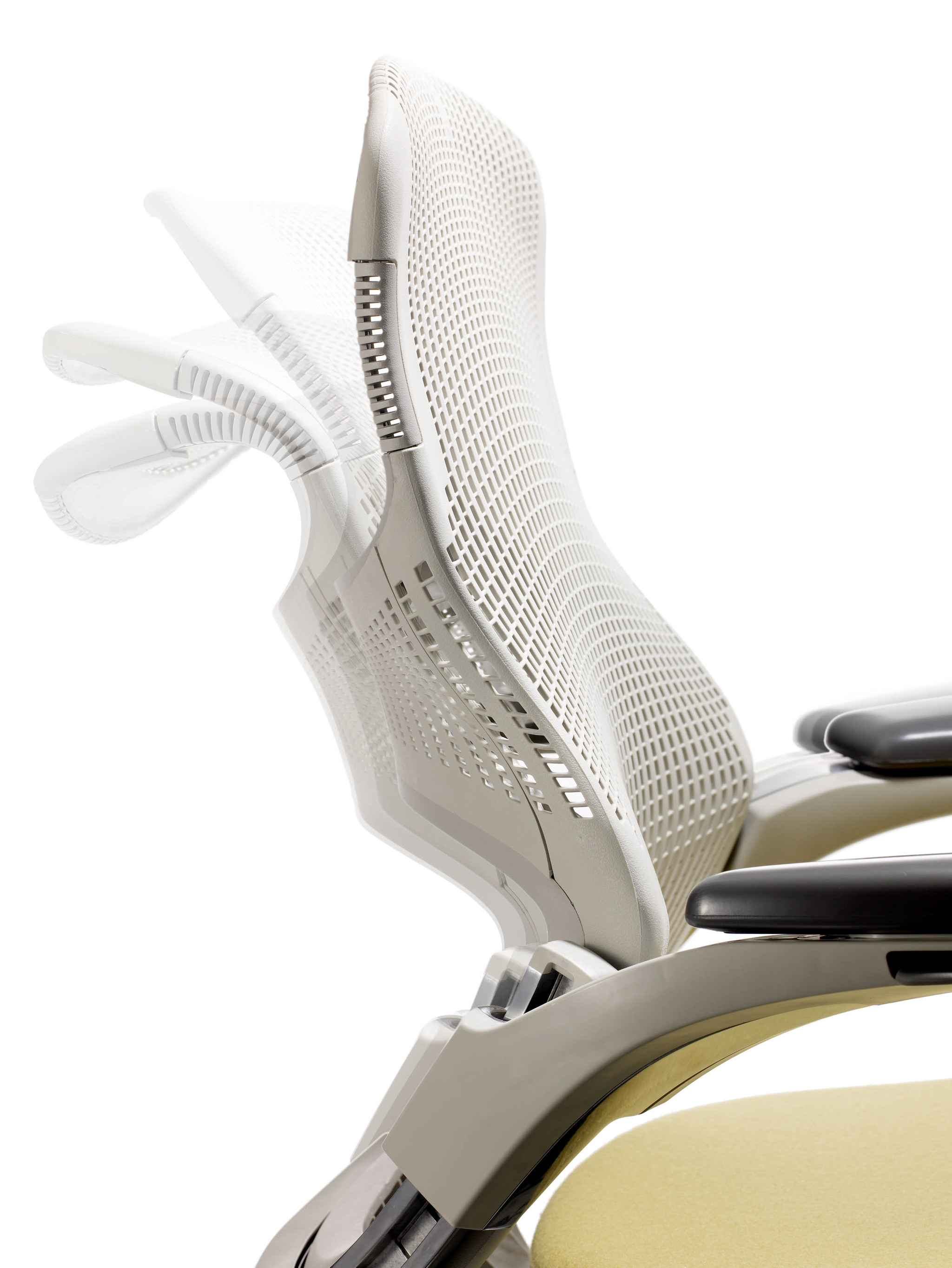

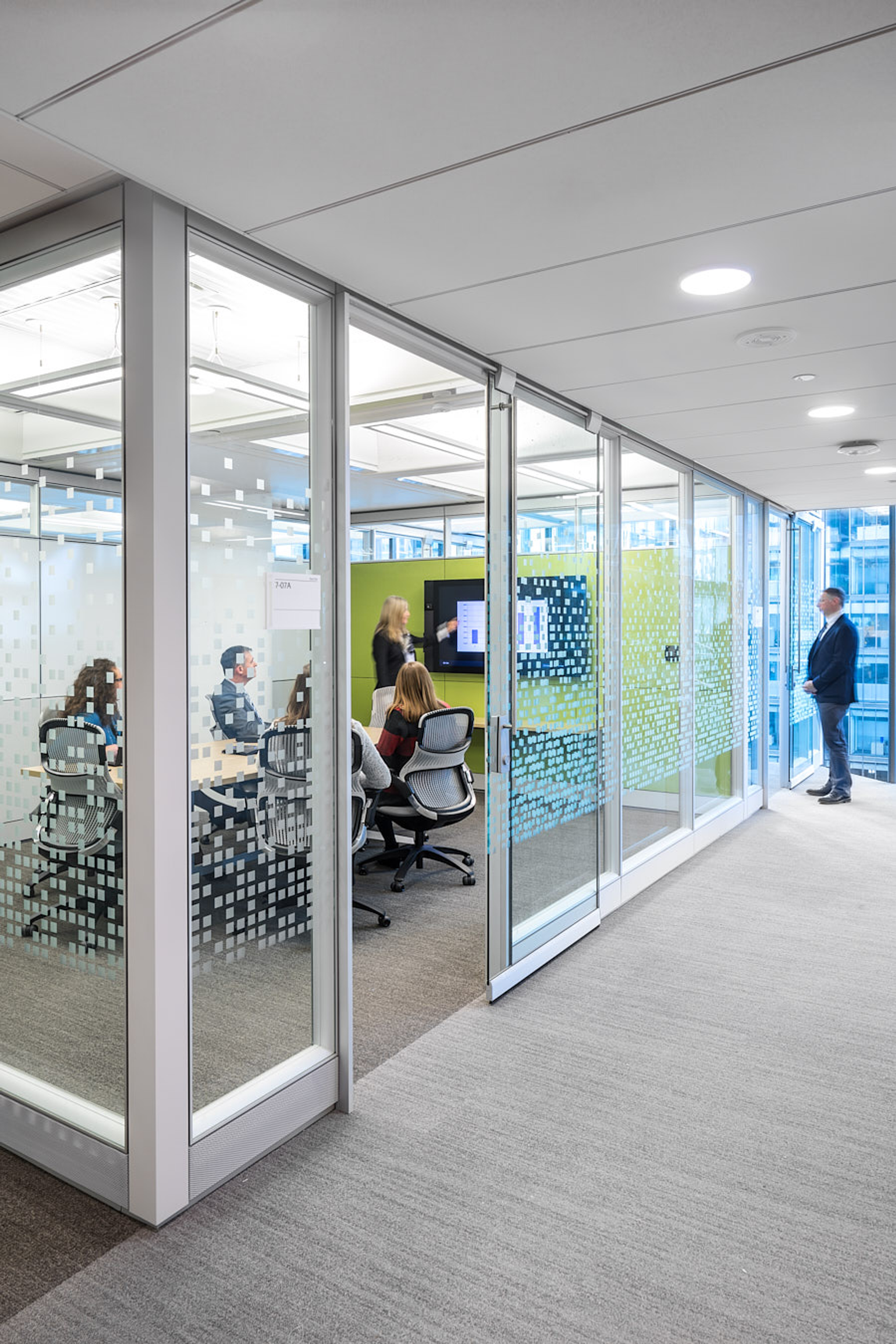
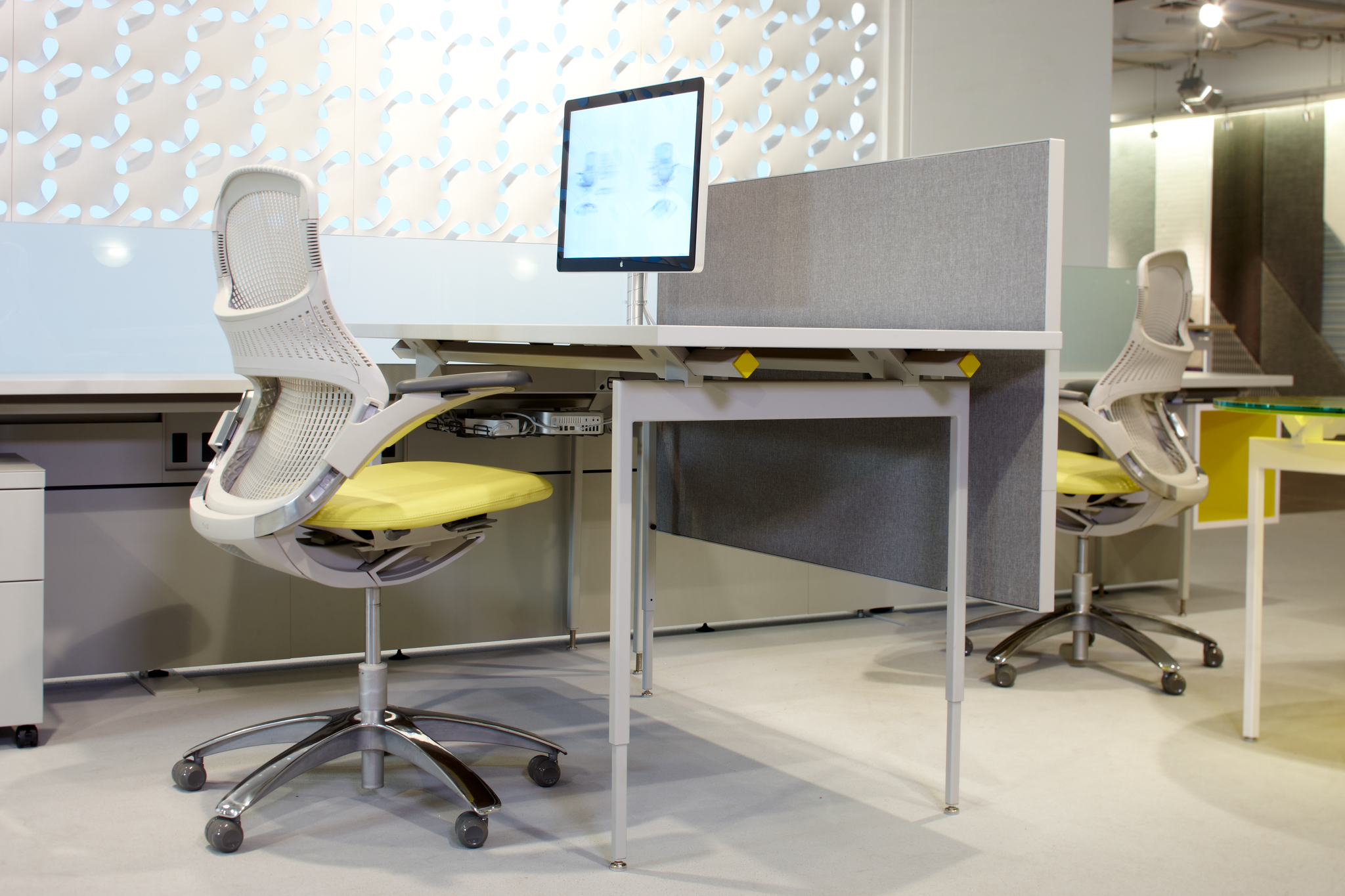
Are you ready to take control of your posture through a better sitting experience? Explore the ergonomic chairs and discover the mixture of design, comfort, and well-being.
Schedule a showroom tour to sit in various ergonomic chairs and find the perfect one for you and your space.
Empowering Productivity and Focus: 5 Benefits of the Office Pod
Rows of workstations, fluorescent lights overhead, and the constant hum of the photocopier are the backdrop of the daily grind for some. Imagine this: you're sitting at your desk, deep in thought, trying to put the finishing touches on a project due in a few hours. Just as you're about to type the last period, the chaos begins.
Rows of workstations, fluorescent lights overhead, and the constant hum of the photocopier are the backdrop of the daily grind for some. Imagine this: you're sitting at your desk, deep in thought, trying to put the finishing touches on a project due in a few hours. Just as you're about to type the last period, the chaos begins. Enter The Noisy Phone Talker: In the cubicle next to yours, your coworker is on a conference call that sounds more like an episode of WWE Smackdown than a business discussion. Her voice booms across the office, detailing the weekend escapades or where she’s traveling to next month. Meanwhile, the meeting room next to your workstation has become a revolving door. Teams are hosting their brainstorming sessions, presentations, and client lunches. The walls are not soundproof, and you can hear every word from every meeting. You feel like an unwilling participant in meetings about projects you're not even a part of. Distractions like these have become a daily battle, but you're not alone. Many employees share your struggle and understand the frustration of maintaining productivity in a setting designed for collaboration.
In today's work environment, in the effort to accommodate the ever-evolving needs of employees, organizations are scrambling to create innovative, flexible spaces; for example, designing spaces for teams to collaborate in while providing private spaces for phone calls, heads-down work and conferences. Since Herman Miller first created the idea for office pods in 1965, they have become a high-demand product optimizing office spaces to achieve the perfect hybrid workspace at a more cost-effective solution.
5 reasons you need an office pod in your office:
Eliminates Distractions and enhances Productivity:
Office pods mitigate one of the most common productivity killers: noise. The constant hum of conversation, phone calls, and various activities can be disruptive in open office environments. Office pods offer a controlled acoustic space where employees can focus without the distractions that permeate the rest of the office.
2. Versatility:
Office pods serve multiple purposes. They offer a comfortable space for private conversations, whether it's a one-on-one discussion or a small team meeting. They also provide an ideal setting for quick calls, focused work, and collaborative brainstorming. For example, the Framery Q, designed for 1-4 people, is ideal for both face-to-face and hybrid meetings, ensuring that your team can engage without disrupting other members in the office.
3. Inclusivity
Modern workplaces are recognizing the importance of accommodating neurodiversity. Neurodivergent employees, such as those with autism or attention-related challenges, often require quiet, controlled environments to perform at their best. Office pods offer them a space to concentrate, gather their thoughts, and work effectively. This inclusivity fosters a positive and supportive work environment where all employees can thrive.
4. Eco-Friendly Materials:
As environmental concerns become increasingly important, office design follows suit. Office pods are crafted to emphasize sustainability, using high-quality, low-waste materials. This not only reduces the carbon footprint of your workplace but also aligns your organization with eco-conscious practices. It's a step toward contributing to a more environmentally responsible office environment.
5. meets the need for privacy
In today's open office layouts, privacy is often sacrificed in favor of collaboration. However, privacy remains crucial for specific tasks, such as confidential meetings, personal phone calls, and focused work that demands privacy. Snapcab creates custom pod sizes tailored to your organization's needs; whether it's height, depth, or width, they can customize and create your ideal solution.
Incorporating an office pod into your workplace isn't just about adding furniture; it's about transforming how your employees work and interact within the office. The benefits span far beyond mere convenience. It can be a game-changer, enhancing productivity, fostering inclusivity, promoting sustainability, and providing much-needed privacy in open office settings. Ultimately, it contributes to an improved overall work experience, making it a valuable investment for any forward-thinking organization.
Want to take your first step into the world of Pods? We’re here to help you – contact us today!
Is the workplace dead? how the work model is affecting real estate
In a world where change is in constant motion, the traditional workplace concept is still being challenged. The rise of remote work and hybrid work models has led to a significant shift in how organizations view their office spaces and is forcing them to evaluate their spaces more frequently. This shift has profoundly impacted the real estate market, particularly regarding the rise of office-to-residential conversions and the repurposing of commercial spaces.
The post-pandemic work model has accelerated the adoption of remote work, leading many …
In a world where change is in constant motion, the traditional workplace concept is still being challenged. The rise of remote work and hybrid work models has led to a significant shift in how organizations view their office spaces and is forcing them to evaluate their spaces more frequently. This shift has profoundly impacted the real estate market, particularly regarding the rise of office-to-residential conversions and the repurposing of commercial spaces.
The post-pandemic work model has accelerated the adoption of remote work, leading many organizations to reconsider their need for physical office space. Some companies opt for a hybrid model, where employees split their time between working from home and coming into the office a few days a week. Others opt to downsize, realizing they don't need as much space if they allow employees to work from home. For instance, some tech giants have announced permanent remote work options for employees. This has led to increased vacancy rates in major cities, with vacancy estimates ranging from 15% to 20%. A prime example is Manhattan, once active with office activity, now seeing an increase in available office spaces as companies rethink their space requirements.
The shift towards remote and hybrid work has significant implications for real estate. With less demand for office space, there has been an increase in the availability of commercial properties, particularly older B and C-class buildings. These buildings, often built in the 70s and 80s, are seeing long-term tenants move out in favor of newer or repositioned spaces. The reasons behind this shift in preference for newer spaces include modern amenities, proximity to transit stations, and the desire for more energy-efficient and sustainable buildings. Newer office spaces often incorporate features like advanced HVAC systems, eco-friendly designs, and integrated technology that align with the changing needs of the workforce.
A potential solution to this growing vacancy problem is repurposing office space for residential use. Converting offices into housing could help address housing shortages in many cities and contribute to sustainability efforts by reducing carbon emissions. This trend has gained momentum in cities like New York and San Francisco, where repurposed office buildings provide much-needed housing options.
However, such conversions are not without challenges. Only 25% of commercial buildings have the right "bones" for residential conversion. Factors such as window depth, building size, and zoning regulations can limit the number of units created. Nonetheless, the potential benefits, both in terms of housing availability and environmental impact, make this an attractive option for urban planners and developers.
Despite these challenges, it's clear that our cities and workplaces are evolving. Downtowns are not going away; they're simply changing. They're becoming places where people can walk to work and enjoy nearby neighborhood staples like bars and restaurants. This shift towards mixed-use urban development creates vibrant, livable city centers catering to residents and employees.
Is there a silver lining to this office vacancy doom and gloom talk? Yes! The silver lining is that smaller companies now have access to high-end spaces at more affordable prices. This presents an opportunity for us, Corporate Environments, to help design beautiful and functional workplaces for your company. Smaller organizations can now compete for prime office locations that were once dominated by larger corporations.
The workplace isn't dead; it's just changing. As we navigate this new landscape, it's crucial to consider how these changes will impact how we work, our cities, and our planet. The hybrid work model presents challenges and opportunities - we must make the most of them. Adapting to this evolving work environment requires creativity, flexibility, and a forward-thinking approach, both in the real estate industry and the needs of employees.
Looking to evaluate your space?
Embracing Neurodiversity: Creating a Culture of Acceptance and Success in the Workplace
In the ever-changing view of the post-pandemic work model, discussions surrounding hybrid and remote work have taken center stage. However, within these conversations, a needed topic still needs to be addressed: the connection between neurodiversity and workplace design and how it impacts individuals with different sensory sensitivities. A recent study by HOK delves into this crucial aspect, shedding light on the significance of inclusive design and accommodations for both hyposensitive and hypersensitive users in the workplace. So, what is neurodiversity?
In the ever-changing view of the post-pandemic work model, discussions surrounding hybrid and remote work have taken center stage. However, within these conversations, a needed topic still needs to be addressed: the connection between neurodiversity and workplace design and how it impacts individuals with different sensory sensitivities. A recent study by HOK delves into this crucial aspect, shedding light on the significance of inclusive design and accommodations for both hyposensitive and hypersensitive users in the workplace. So, what is neurodiversity? Most people function within a considerable range, neurotypically. However, a significant fraction of the population extends into ranges considered neurodiverse, a natural range of variation in human cognition. A range of conditions, including dyslexia, anxiety, attention deficit hyperactivity disorder, and autism spectrum disorder, are included within the neurodiverse umbrella.
While the pros and cons of hybrid work models have dominated headlines, the experiences of neurodivergent individuals in the traditional office setup have often gone unnoticed. HOK's research reveals that this group faces unique difficulties stemming from the sensory environment of a typical office. Bright lights, constant background noises, and rigid structures can be challenging for individuals who process sensory information differently.
The study highlights several on-the-job accommodations that can drastically improve the workplace experience for neurodiverse employees. Among these are adjustments such as reducing the intensity of lighting, allowing regular breaks for physical activity or a change of scenery, and fostering an overall adaptable environment. These small yet impactful changes can create an inclusive workspace that caters to a diverse range of sensory needs, ultimately boosting the comfort and productivity of all employees.
In essence, inclusive design is the driving force behind addressing these challenges. Instead of molding individuals to fit the environment, organizations are encouraged to reshape their surroundings to embrace the strengths and talents of every employee. This approach not only supports neurodiversity but also sets the stage for a more dynamic and innovative workforce.
The "Designing a Neurodiverse Workplace" research proposes a powerful solution: providing choices. Recognizing that individuals possess varying sensory preferences and needs, the study suggests that offering a range of options empowers employees to curate their workspace in alignment with their comfort levels. This could mean providing quiet spaces for those hypersensitive to noise or offering sensory-friendly corners for those requiring sensory stimuli to focus. Ultimately, the goal is cultivating an environment where each employee can thrive.
As the dialogue around post-pandemic work models unfolds, it is imperative that the discourse expands to include the needs of neurodiverse individuals. The HOK study serves as a reminder that workplace design is not a one-size-fits-all. By embracing neurodiversity and supporting inclusive design principles, organizations can create spaces that truly welcome and celebrate every employee's unique talent, experiences, and sensory preferences. Doing so, they pave the way for a future where diversity is acknowledged and embraced. With services like furniture design/specification to workforce strategy, at Corporate Environments, we are dedicated to providing solutions to encourage everyone to reach their full potential. Schedule today to experience it firsthand and see how we can transform your workplace.
Research provided by HOK:Designing a Neurodiverse Workplace
Designing Tomorrow's Workplaces: 5 ways ai is influencing work environments
The commercial interior industry is undergoing a transformation with the integration of artificial intelligence. This revolutionary technology utilizes AI-powered algorithms to analyze various data points, including employee preferences and work patterns. The result is the creation of optimized office layouts that enhance efficiency and encourage collaboration among employees. Thanks to AI-generated data, data-driven decision making becomes possible, allowing furniture manufacturers and designers to adapt their products to meet the evolving needs of the workplace.
As technology continues to advance at an unprecedented pace, industries across the board are experiencing significant transformations. The commercial interior industry is no exception and is ready to undergo a revolution with the integration of artificial intelligence (AI) in the workplace. AI's impact on the commercial furniture industry promises to enhance productivity, optimize space utilization, and provide personalized experiences for clients and staff. Let’s explore how AI is reshaping the modern workplace.
1. Smarter Office Design
AI-powered algorithms are transforming the way office spaces are designed. By analyzing substantial amounts of data, including employee preferences, work patterns, and collaboration requirements, AI can generate optimal office layouts. These layouts are tailored to maximize efficiency, promote creativity, and foster collaboration among staff. It can also consider factors such as natural lighting, noise levels, and air quality to create healthier and more productive work environments.
2. Intelligent Space Utilization
In large office buildings, it is often challenging to determine the optimal utilization of space. AI can play a crucial role in addressing this issue. Through real-time occupancy tracking and sensor technologies, AI algorithms can monitor how different spaces are used throughout the day. This data can be used to optimize space allocation, identify underutilized areas, and make informed decisions on office expansions or reconfigurations. By minimizing wasted space, companies can reduce costs and create more flexible and adaptable work environments.
3. Personalized Employee Experiences
AI empowers businesses to provide personalized experiences for their employees. Smart furniture embedded with sensors and AI capabilities can learn individual preferences, such as preferred desk height, chair settings, and lighting conditions. It can also anticipate employee requirements, such as automatically adjusting temperature or suggesting break times based on workload and stress levels.
4. Enhanced Employee Well-being and Safety
Workplace well-being and safety are now considered critical for organizations. AI can help address these issues by monitoring environmental factors and proactively identifying potential dangers. For instance, AI-powered systems can detect and respond to air quality issues, ensuring a healthier workspace for employees. Additionally, AI can provide insights on ergonomics and posture, reminding employees to take breaks, stretch, or adjust their seating positions to prevent long-term health issues.
5. Data-Driven Decision Making
Lastly, AI generates great amounts of data that can inform decision-making processes in the commercial furniture industry. By analyzing this data, businesses can gain valuable insights into employee behavior, workspace utilization, and furniture performance. These insights can guide furniture manufacturers and designers in creating products that align with changing workplace needs, optimizing comfort, functionality, and aesthetics.
The commercial furniture industry is on the verge of a transformative journey with the integration of AI in the workplace. By leveraging AI technologies, businesses can revolutionize office design, optimize space utilization, personalize employee experiences, enhance well-being and safety, and make data-driven decisions. The future of the commercial furniture industry will be characterized by dynamic, adaptable, and intelligent workspaces that prioritize employee comfort, productivity, and satisfaction. Embracing AI in the workplace will redefine how we perceive and experience the modern workplace.
Exploring Post-Neocon perspectives | Part ii
As organizations increasingly prioritize sustainability and environmental consciousness, as seen at NeoCon and Design Days, furniture design is aligning with these principles to create more eco-friendly and responsible workspaces. Additionally, the intersection of social dynamics and technology integration in the design of contemporary office furniture was highlighted by the one and only, Framery.
Welcome to Part 2 of our two-part post Neocon blog series on the ever-evolving world of workplace design and furniture. We wanted to bring you more insights since our team endured rain, gale-force winds, and walked over 155,000 steps combined to experience it all (and so you didn't have to).
In Part 1, we discussed the need for flexibility, collaboration, and reconfigurable furniture in today's fast-paced work environments, and we introduced the innovative Morse Table System by NaughtOne and the Team Cart by Global Furniture Group as solutions to seamlessly transition between different work modes.
In our previous post, the most prominent insights highlighted were as follows:
COLLABORATIVE AND FLEXIBLE FURNITURE FOR CROSS-GENERATIONAL SPACES
MOBILITY AND RECONFIGURABLE FURNITURE IS ESSENTIAL
GREEN IS KING- SUSTAINABILITY IS EVERYWHERE
SOCIAL + TECHNOLOGY= A WINNING COMBINATION
As organizations increasingly prioritize sustainability and environmental consciousness, as seen at NeoCon and Design Days, furniture design is aligning with these principles to create more eco-friendly and responsible workspaces. Additionally, the intersection of social dynamics and technology integration in the design of contemporary office furniture was highlighted by the one and only, Framery. With the rise of remote work and virtual collaboration, the way we interact with our colleagues and utilize technology has transformed. Furniture designers are harnessing the potential of this winning combination to enhance communication, productivity, and overall workplace experience.
Green is King - Sustainability is Everywhere
Sustainability is becoming a driving force in furniture design, with manufacturers and designers incorporating eco-friendly materials into their products. NaughtOne has consistently strived to make a positive impact on the world. They have been at the forefront of environmental certifications, designing, and manufacturing sustainable products. A great example of NaughtOne’s product line is the Pippin chair. Designed by a talented British Furniture designer, Lucy Kurrein. The Pippin chair gained recognition and exposure in the NaughtOne showroom at the Fulton Market Design Days.
Pippin was created with longevity in mind and a focus on the end of its lifecycle. Every component was meticulously designed to facilitate easy disassembly when its lifespan is complete. Pippin comes with a unique feature—a tailored cover that can be zipped on and off, giving the chair its sophisticated charm. This removable cover not only allows for easy replacement in the event of damage or stains but also enables customization options to suit different styles. In addition, the construction of the chair is entirely free from glues and staples, ensuring easy disassembly and facilitating proper recycling at the end of its lifecycle. NaughtOne's commitment to sustainability is evident in the thoughtful design of Pippin and according to its Product Sustainability Statement 89.8% is recyclable content embodying their dedication to creating products that are both environmentally responsible and aesthetically appealing.
SOCIAL + TECHNOLOGY= A WINNING COMBINATION
As mentioned before, hybrid work is not going anywhere, it is here to stay and with the powerful combination of social dynamics and technology in the modern workplace Framery presented an innovative product at Neocon offering visitors to experience it in person. With the increasing integration of digital tools and collaborative platforms, Framery Contact by Framery is disrupting how technology works to connect people in offices on opposite sides of the country, or even the other side of the world.
Framery Contact is a virtual meeting pod that comes closer to recreating the experience of a real face-to-face conversation than any other technology on the market. The pod is designed to isolate visual and acoustical elements enhancing the sense of being in a shared space with the person on the screen. Our team tried it out firsthand and it’s no exaggeration to say that we were blown away. It was as if the person on the screen (which we couldn’t detect where it began and ended) was sitting in the same booth with us. According to Framery’s research, a single flight between London and New York produces 1.7 tons of carbon dioxide whereas the total emissions from manufacturing, five years of use, and recycling a Framery Contact pod is only 1.4 tons. This innovation is convenient, an absolute perfect combination of social and technology integration with a sustainable aspect to it as well.
From smart furniture that integrates with smart devices to immersive meeting spaces that foster engagement, the insights highlights are shaping the future of workspaces. The future workplace is here, and it's transforming the way we work, collaborate, and thrive.
Exploring Post-Neocon perspectives | Part 1
In the ever-evolving commercial interiors industry, the concept of cross-generational spaces has gained significant value. With diverse age groups working together in modern workplaces, there is a growing need for furniture that promotes collaboration and flexibility. Collaborative and flexible furniture not only fosters teamwork and communication but also accommodates the varying needs and preferences of individuals across different generations.
Let’s set the stage for you. It’s 9:00 am on a Monday morning and today is an in-office workday, but your calendar is filled with back-to-back meetings and zero down time to breathe or socialize with your colleagues. You find yourself constantly moving between working, meetings, and collaboration time. All these rapid shifts are a daily reality, and you find yourself moving from one office space to another based on the necessity of your work mode. This is typically by scooping up laptops, floorplans, and coffee mugs and lugging them from room to room. But what if you could simply slide them across the table? What if there was an all-in-one system that made switching work modes as simple as moving over to the next seat beside your colleague who is ready to collaborate?
The introduction of the Morse Table System by NaughtOne during the Fulton Market Design Days showcased the flexibility and infinite possibilities that can solve the need we described above. Because hybrid is here to stay, the office continues to be a necessity. The Morse Table system serves multiple purposes in one day from a solo workspace to collaboration area. The Morse Table system fits in different markets such as universities, design studios, shared office spaces, and even airports and is one of the most customizable systems we’ve seen to promote a successfully flexible workspace.
This year NeoCon and Fulton Market Design Days showcased new products, like Morse, from manufacturers, highlighting the ever-changing role of workplace design, redefining flexibility, and solving real world challenges. The exhibition floors displayed many things, but the following insights were the most prevalent:
COLLABORATIVE AND FLEXIBLE FURNITURE FOR CROSS-GENERATIONAL SPACES
MOBILITY AND RECONFIGURABLE FURNITURE IS ESSENTIAL
GREEN IS KING- SUSTAINABILITY IS EVERYWHERE
SOCIAL + TECHNOLOGY= A WINNING COMBINATION
Collaborative and Flexible Furniture for Cross-Generational Spaces
In the ever-evolving commercial interiors industry, the concept of cross-generational spaces has gained significant value. With diverse age groups working together in modern workplaces, there is a growing need for furniture that promotes collaboration and flexibility. Collaborative and flexible furniture not only fosters teamwork and communication but also accommodates the varying needs and preferences of individuals across different generations.
MillerKnoll Design Days introduced the Fuld Nesting Chair designed by Stefan Deiz. The nesting chair is ideal for workshop spaces where the chairs can “nest” together when not in use to save space and allow for easy reconfiguration. Because of its contoured shape it allows users to remain comfortable as they shift around. Available late summer, so stay tuned!
Mobility and Reconfigurable Furniture is Essential
Movable and reconfigurable furniture has gained significant popularity, allowing spaces to serve multiple functions in a day and switch purposes in a matter of minutes. It has become essential in the commercial interior industry. Its adaptability, cost-effectiveness, and ability to repurpose your workspace on the fly make it an ideal choice for organizations aiming to create versatile spaces.
A great example of this was seen in the Global Furniture Group Showroom with Team Cart from their new spaces line launching this fall. Team Cart enables the creation of spaces where teams can collaborate and connect in a flexible work environment. In its basic form the cart is a coat rack and can be accessorized with shelves, white board panels, as well as tackable panels. The panels can be full size, they clamp on vertical rails that can be adjusted or stacked and be used on a coordinating wall track system. The cart can also be used in combination with a media unit, and it becomes a mobile media cart for presentations!
In Part 2 of this blog series, we will delve deeper into the next two insights from sustainability to the social + technology combination. Stay tuned for an exciting exploration of how technology, design, and sustainability are shaping the furniture of tomorrow.
celebrating diversity
In a world where different cultures and perspectives clash, it is more important than ever to understand and celebrate cultural diversity. In fact, diversity is something that should be celebrated every day, not just on World Day for Cultural Diversity. As a company that pursues diversity within our walls, we want to commemorate this special day by sharing the voices of our employees.
In a world where different cultures and perspectives clash, it is more important than ever to understand and celebrate cultural diversity. In fact, diversity is something that should be celebrated every day, not just on World Day for Cultural Diversity. As a company that pursues diversity within our walls, we want to commemorate this special day by sharing the voices of our employees. Our team is composed of people from various cultural backgrounds, and we want to highlight their unique voices by sharing things they feel people should know about their culture.
“Greeks have an unwavering pride in our culture, our passion for coffee, and deep respect for family and traditions. We carry our cultural heritage as a badge of honor. Coffee is vital and serves as a symbol of savoring the present moment. Family and parties lie at the heart of our culture!”
“Pakistanis go above and beyond to ensure the comfort and happiness of our visitors, whether it is a cup of chai or just a warm welcome, we take pride in our hospitality. Apart from our famous spices, herbs, turmeric infused dishes, our clothing is a vibrant reflection of our country’s heritage.”
“What people outside of Mexico refer to as, “Mexican Food” is often, Tex-Mex. Our cuisine is known for its bold flavors, colorful presentations, and diverse ingredients. From street tacos and enchiladas to rich mole sauces, Mexico embodies a celebration of flavors. It is not only known for our vibrance and traditions, but also known for inventing Color TV by Guillermo Gonzalez Camarena who was only 17 years old.”
“Egyptians are known for their awe-inspiring pyramids, hieroglyphics, and remarkable civilization, the ancient Egyptians continue to fascinate and intrigue us to this day. We invented a lot of things we use today like musical instruments, keys, cosmetics, toothpaste and more. Not many know that both men and women wore makeup to protect the skin from the hot sun, and of course they also believed it had healing powers. Green and black makeup were common, green made from copper and the black was lead. Interesting to learn the origins of modern items reach back into history that far.”
Celebrating diversity should not just be a one-day event but something that we should practice every day. As a company, we are committed to creating an inclusive workplace where everyone feels valued and respected. We hope that this blog has inspired you to embrace the richness that cultures bring. We encourage you to share your experiences and thoughts on cultural diversity with us and see how we can work together to create a more diverse and inclusive workplace for your organization.
Remember: diversity is our strength!
Our Employees Speak Out: Why They Choose to Work at Corporate Environments
So, what makes a workplace amazing? Is it the company policy, the office amenities, the bonus structure, pay, or work model? We can attest that it’s the people that we hire, the people who help build company culture because without them Corporate Environments would not be as successful as it has been today.
Corporate Environments was recently recognized by the AJC as a Top Workplace for 2023! So, what makes a workplace amazing? Is it the company policy, the office amenities, the bonus structure, pay, or work model? We can attest that it’s the people that we hire, the people who help build company culture because without them Corporate Environments would not be as successful as it has been today. Our goal at Corporate Environments is to create an environment that supports employee growth, well-being as well as spark innovation and deliver unmatched client experiences. We asked a few of our employees why they decided to join, stay, and apply from within.
Meet some of our employees!
Why did you decide to apply from within rather than search for outside opportunities?
ANDREA GOINGS
Architectural Solutions
Project Coordinator
Atlanta, GA
I have been with CE for 3+ years and truly have great admiration for the business and quality we as a company present. The company is ever changing and progressive, and I say that because I am in my career as well. When the opportunity was listed internally for the Architectural Solutions Project Coordinator, I quickly applied. It was a different realm than furniture, but it was an opportunity to make myself better and learn more.
Why did you decide to join corporate environments?
BRIAN BRIGGS
Project Manager
Atlanta, GA
After my initial phone interview with the recruiter, I began my research on who and what this company was about and in doing so, I became more and more intrigued with the overall make up, purpose and vision of the company. Then throughout my interview process, I began to meet the people that make up this company and experience the culture which helps drives this vehicle called CE to success.
What was your experience like on your first day?
So far, during these long industrious few weeks I’ve been here, lol … I have enjoyed every moment of the ride. It’s like learning a new language every day I come in to work, which excites me beyond words. My baptism began with excel overload and status reports with a few site visits sprinkled in along the way. Like a kid at Christmas who can’t wait to show off his new gifts, I can’t wait to show this company that the investment they made in me is worth its weight in gold.
why did you decide to apply from within rather than search for outside opportunities?
EMILY SMITH
Healthcare
Project Coordinator
Atlanta, GA
I have always had an ambitious attitude when it comes to my work life and one of the key factors for me at work is the opportunity for growth. I joined the CE family in June of 2022 and from day one I always told everyone I was eager to grow and expand my knowledge within. As soon as the position for Healthcare Project Coordinator was posted, I knew that it was something I wanted to apply for. I really enjoy being a part of CE and am so thankful that opportunities to be promoted from within.
WHAT MADE YOU STAY AT CORPORATE ENVIRONMENTS?
KURT MEYER
Sr. Sales Representative
Atlanta, GA
I loved the market but wanted to engage deeper with the entire project process. CE gave me that opportunity. Once you’re here you’re hooked! It’s a family.
It sounds cliché, but your clients become your friends and family as well. I have many clients who we’ve partnered on relocations 4-5 times over the years. I feel lucky to have found a place I love.
why did you decide to join corporate environments?
MIA PHAN
Project Designer
Savannah, GA
I really thought it would be a good fit for me to make the move. It is a woman owned company, has an array of talented people, represents brands that I like in commercial design, and it seemed like everyone enjoys their job – which is an important detail that I was missing at the time.
What was your experience like on your first day?
I noticed that everyone is really welcoming and genuine, and no one is too important for you to reach out to and have a conversation. I think it is extremely helpful that the designers here include the whole team on helping source items for different projects if it is needed because it really pulls together everyone’s knowledge for the benefit of the project.
We hold the Top Workplace award with high honor. Corporate Environments encourages employee feedback and allows every voice to be heard. Our vision is to be the company people want to do business with and people want to work for. When employees go through the onboarding process, they take part in the CE culture including monthly birthday celebrations, team lunches, happy hours, team outings, and more! But we know any company can provide free lunches and free beer, so what sets us apart from our competition? The people that cultivate our culture.
Being part of the commercial interior office design industry means that competition is everywhere, so to set Corporate Environments apart from the rest, we continue to place employees as our most valuable resource and priority and strive to retain our wonderful team.
As we continue to strengthen and grow our team, we are always looking for top talent. Check out our current open positions.
[ Search all Jobs | LinkedIn ]
From Employee to Entrepreneur: A Journey of a Woman-Owned Furniture Dealer
“DO YOUR BEST IN WHATEVER JOB YOU HAVE, NO MATTER WHAT IT IS. LEARN THE MOST YOU CAN, EXPAND YOUR EXPERIENCE AND DO SOMETHING DIFFERENT. NEVER BE AFRAID TO TRY SOMETHING DIFFERENT.” - Karen Hughes
“DO YOUR BEST IN WHATEVER JOB YOU HAVE, NO MATTER WHAT IT IS. LEARN THE MOST YOU CAN, EXPAND YOUR EXPERIENCE AND DO SOMETHING DIFFERENT. NEVER BE AFRAID TO TRY SOMETHING DIFFERENT.”
- KAREN HUGHES
Emerging from the activities of labor movements during the twentieth century in North America and Europe, in 1977, the United Nations officially established March 8th as International Women’s Day. A decade later, the National Women’s History Project petitioned to designate March as Women’s History Month. Year after year, the recognition has increased globally, and society has celebrated many contributions by women to history. Because this year’s Women’s History Month theme was Celebrating Women Who Tell Our Stories, Karen Hughes, CEO + Owner of Corporate Environments, shared her story with our team. It was an intimate and encouraging opportunity to learn about her journey of being an auditor to a business owner.
From living out of a suitcase, wearing a hard hat, and being a stay-at-home mom to becoming CEO + Owner of Corporate Environments, Karen accurately represents a perseverant person, taking every opportunity with a leap of faith. Her story is a testament to her courage and willingness to take risks. Growing up with brothers, Karen often found herself being very competitive, and with the mindset of “whatever they (her brothers) can do, she could do better,” she was able to hack the ideology of how boys could do some things girls couldn’t.
To prove everyone that she could do it, she went off to Auburn University and graduated with an accounting degree and later earned a master’s degree in accounting. After interviewing with several companies, Karen moved to Birmingham, where she worked in the auditing department which required her to travel extensively due to many of her clients being out of state. Despite the challenge of balancing work and family life, Karen persevered until she realized that living out of a suitcase away from home during the week was not what she wanted. Time passed, and Karen eventually transitioned into a different field- manufacturing, where a hard hat and boots were required. After the unions went on strike, she learned she would have to live at the plant for months and realized she did not want to be locked in, so she opted to move on.
After that experience, Karen started auditing for an office furniture company. From the start, many concerns arose, and she realized that the organization was not abiding by the accounting principles, which did not align with Karen’s beliefs. Karen decided the position was not the right fit for her and again chose to move on. After having two children and relocating to Atlanta, Karen decided to take a break from work to become a stay-at-home mom. However, when the 1990 savings and loan crisis hit, it took a toll on her husband’s commercial real estate company, and they began downsizing, downsizing, and downsizing until finally it reached the point where they both felt that Karen would need to find a job.
Once again, Karen had to go on the job hunt. While on the search for a job, she met John Harris, who was looking for someone to help run his furniture dealership’s internal operations at that time. They talked and checked each other out, and Karen finally decided it might be a good fit. Corporate Environments started with about eight employees, and after the merger with Ball Stalker, CE became a $25 million company overnight. It was like drinking from a fire hose. The constant growth and huge opportunity were exciting and required a lot from Karen to consolidate everything while running a business with little experience in knowing how to.
Through all this growth, John decided to move to the next phase of his life and sell the business. One day, he approached Karen with an offer, and for a second, she thought he had been drinking at lunch because she did not have the means to purchase such an organization. But her background in accounting brought out her analytical side, so she sat down and figured out how to make this happen. After careful thought, Karen moved forward with the acquisition.
A month before they closed the deal, CE won $10 million in business. At that time, they had a whole installation side of the business with a 100,000-square-foot warehouse and grew to 60 employees working in the field. Unfortunately, after 9/11, CE lost 30% of its business. Eventually, Karen decided to sell the installation side of the business, which had many overhead costs. After so many economic downturns, today, she claims it was the best business decision made that helped prevent any future financial drainage to CE’s stability.
Fast-forward to today, Corporate Environments has become a successful furniture dealership in the Atlanta Metropolitan area and has expanded into other southern regions, such as Savannah, Georgia. Corporate Environments is proud to say that we are woman-owned, and Karen’s story has made that even more real today. We continue to celebrate the women that make things possible.
Have you been inspired by a woman in your life?
let us know in the comments below!
Looking for love? These task chairs could be “the one.”
Have you ever considered how much time you spend sitting at your desk? We spend more time swiping on dating apps than thinking of the impact the chair we sit on has on our body and day-to-day productivity. Think about it, we spend about eight hours a day at work, and out of those eight hours, we are oblivious to the comfort level of the chair we’re sitting on.
February is the month where love fills the air. Although it is one of the shortest months, love always seems to saturate the entire month. During this time, many single people search for someone to spend Valentine’s Day with, but they’re not the only ones doing the searching- organizations are also searching to match their staff with the right task chair that supports employees during long sitting hours as well as after-hours conversations in the office.
Have you ever considered how much time you spend sitting at your desk? We spend more time swiping on dating apps than thinking of the impact the chair we sit on has on our body and day-to-day productivity. Think about it, we spend about eight hours a day at work, and out of those eight hours, we are oblivious to the comfort level of the chair we’re sitting on. Is that chair meeting our basic lumbar support needs? Is it causing that back pain we keep complaining about? Next time you notice pain or any discomfort, do some research on your current task chair.
We all need a soulmate that ensures we are comfortable while still bringing design aesthetics and ergonomic support. Finding the right task chair can be as tedious as getting a perfect match on Tinder, but we’ve done the work for you and have swiped right on the four most popular task seating chairs. So, if you’re looking for a long-term relationship, sit back and picture yourself sitting on one of the following chairs:
Let’s get to know the matched MillerKnoll candidates:
Aeron- By Herman Miller
Aeron is part of the Performance task section offering a variety of benefits, including a smarter weight distribution through 8z Pellicle, adjustable PostureFit SL for total spinal support, and balanced recline and natural movement by the Harmonic 2 Tilt. The Aeron compatibility is measured in three settings: Dedicated, Shared, and Group. Meaning the Aeron chair can acclimate to any setting while supporting you along the way. If you’re into sustainability, this chair is your perfect match; it contains over 50 percent recycled materials made with ocean-bound plastic. Some of the other key differentiators are the following:
Suspension seating with full ergonomic support
Iconic design that complements any space
The industry benchmark for ergonomics since 1994
Accommodates the widest range of body types/sizes
Verus By Herman Miller
If you’re still deciding whether you want a short-term or long-term relationship, Verus is the right one for you. Its ability to fit any aesthetic guarantees comfort to any type of sitter. It is the ergonomic chair for anyone and everyone at any time of the day. It’s quiet form and versatile design can shift this to any workplace aesthetic, while keeping your finances looking good. Not only is this chair the affordable type, it also comes from a diverse family, including the Verus Plus Chairs, Verus Side Chairs, and the Verus Stools. So, the comfort doesn’t stop at Verus, the legacy is continued by versatile options. Now, you decide which chair is best for you based on its differentiators:
Budget-Conscious
Rectilinear design
Versatile design
Wide range of selections
Generation by Knoll
Looking for a nontraditional love? Generation by Knoll combines freedom, holistic ergonomics, and elastic design to bring in a flexible back with a fun style. This chair encourages free expression, creativity, and engagement in any environment; it’s the partner that will bring out the best in you, even on a gloomy day. This candidate has gone above and beyond to receive the Best of NeoCon Gold Award for Seating in 2009, especially based with following differentiators:
Unparalleled flexibility
Frameless Flex Back ensuring optimal support for shoulders
Frameless Flex Seat
Dynamic Suspension providing weight-compensated without metal links/springs
Continuous lumbar support
Life by Knoll
Life by Knoll is the chair that will bring a joy to your work experience. It’s curves, slim silhouette and smooth movements set a standard of sophistication in design and ergonomics. The Life chair enriches the workplace with its light aesthetic, broad color, and finish palettes. It is a chair that brings beauty, comfort, and durability to the table. Not only is it supportive, it is also engineered for the environment. Its use of minimal materials and easily replaceable components help extend its usefulness. If you suffer from lumbar or shoulder pain, this is the chair that is paired with a back suspension fabric that will provide support in those areas, don’t go another day with pain, choose Life.
We get it. There are a lot of chairs in the sea, but it is important to pick the one that suits your needs. Choosing the right task chair can be challenging, tedious, and very exhaustive. With the number of options available, researching for the ideal chair can consume a lot of time, so we’ve narrowed down the list to the top candidates from the MillerKnoll Collective of Brands we think you should consider. Who knows, maybe you’ll swipe right and find your happily ever after (chair)!
WHAT IS YOUR FAVORITE TASK CHAIR?
LET US KNOW IN THE COMMENTS BELOW!
After install, what’s next?
Organizations refresh, move, or rebrand their workspace every day, and with that comes a high investment of money and time. During the first part of the year, it is common for organizations to reevaluate their space and reconfigure all or slightly tweak where needed. Regardless of the magnitude of space change, our Day 2 Service Program helps your organization manage the upkeep of your interior furnishings, ensuring your products last longer and that your workspace continues to perform at its very best.
It’s 2023, and after months of going back and forth with contractors, designers, and dealers, your newly renovated office space is set and ready to accommodate your employees. Since the pandemic, the entire office has had the luxury of working remotely, but everyone is now eager to get back into the office to socialize with their colleagues. Walking in on the first day in the new office, the smell of new furniture and the sight of fresh paint fills the space. Something has changed. You can’t put your finger on what it is. Then it hits you as you find yourself walking through the space and seeing employees collaborating and having conversations. The office fills with conversations, excitement, and motivation.
Organizations refresh, move, or rebrand their workspace every day, and with that comes a high investment of money and time. During the first part of the year, it is common for organizations to reevaluate their space and reconfigure all or slightly tweak where needed. Regardless of the magnitude of space change, our Day 2 Service Program helps your organization manage the upkeep of your interior furnishings, ensuring your products last longer and that your workspace continues to perform at its very best.
Chip Allen, Director of Sales, describes the Day 2 Services Program as “a constellation of solutions” for the client. Not only does Corporate Environments assist in planning and installing the new space, but we are experts in maintaining your investment after the project is completed. The Day 2 Service Program answers the following questions:
Project Management– is internal business keeping you from an efficient transition?
Project Design– is your office furniture selection preventing employees from staying productive?
Installation– need help building your systems workstations?
Reconfigurations- going through daily internal moves of people and furniture?
Relocations– is your organization considering moving to a new location?
Warehousing- is that excess inventory taking up space in the employee resource area?
Warranty- is that new height adjustable executive desk having mechanism issues?
Reupholster– is that soft seating in your lobby showing its age with worn spots, tears, or stains?
Wood Furniture Repair- have several of your Knoll Islands Collection tables received gouges over time?
Decommission & Liquidation- what do you do with existing furniture?
Just like most physical things, commercial furniture depreciates over time. Furniture is an investment, an investment that is typically replaced every 7-10 years. CE’s Day 2 Services can provide a liquidation option that may reduce the cost of knockdown and removal, and in some cases, pay you directly for your used furniture.
The relationship and support you enjoyed during the project phase continue even after everything has been installed. It can begin immediately after installation. From prior experience, we’ve seen the work model change in a blink of an eye. As we all faced during the pandemic, transitioning to working from home has become a new offering employers now implement in their work model. Some organizations are 100% remote, while others use a hybrid model. As an organization, having a workspace that can be flexible and accommodating as it changes is vital to your continued growth. Every organization needs the same things to function smoothly. First, the ability to adapt quickly to change. Next, concentrating on your core business initiatives. How can you accomplish both with ease? By reducing the time spent on managing furniture changes/installations. With a comprehensive range of workspace solutions, Day 2 Service Programs are designed to meet your specific needs, ensuring that your unmatched service continues, even after your installation.
ASK US ABOUT OUR DAY 2 SERVICES PROGRAM
HEALING + PRODUCTIVITY FROM FURNITURE? IT’S POSSIBLE AND HERE’S WHY IT MATTERS
When we think about healthcare, what comes to mind? Insurance, hospitals, doctors, patients are probably the first things that popped into you mind. We typically think about everything else other than how furniture and design impacts healthcare users: the patients, guests, and caregivers.
When we think about healthcare, what comes to mind? Insurance, hospitals, doctors, patients are probably the first things that popped into you mind. We typically think about everything else other than how furniture and design impacts healthcare users: the patients, guests, and caregivers.
It took a virus that shutdown most parts of the world to rethink the healthcare workplace, shifting the focus onto creating an intentional work environment that addresses employee values and priorities through furniture. During COVID, our hospital employees were on the frontline- working extended hours, sacrificing time with their loved ones, and, most importantly, putting their well-being aside to put patients’ needs first. Because of the labor shortage of essential workers, many felt burned-out and have moved away from the healthcare industry in search of employers that will help support their mental well-being through benefits and policies. After experiencing a worldwide pandemic, the focus has switched to reimagining and redesigning the employee experience in healthcare- where remote work isn’t possible- so building spaces to reflect the value caregivers bring has become as essential as the workers themselves.
Showcased by many different booths at the Healthcare Design expo (HCD), manufacturers made it apparent that they too have recognized this need, demonstrating their ability to push design limits in healthcare, encouraging healing, productivity, comfort, and employee retention. Last month Elizabeth Harris and Jeff Durr, two of our dedicated CE Healthcare team members, attended the HCD Expo + Conference in Houston, Texas. Many key vendors, including Millerknoll, Kwalu, OFS | Carolina, Wieland, and Global, showcased creative solutions to foster flexibility, collaboration, and workload management in the workplace. The CE duo engaged with client Levino Jones from Medical Interiors, known for designing medical offices and outpatient centers, and dove headfirst into the importance of having the right furniture and design in healthcare spaces to improve patient satisfaction, retain employees, and provide durable solutions. Designing spaces in healthcare can be complex because it requires striking a balance between efficiency and the extensive planning required in high occupancy and contagious areas. In the end, having the right furniture and design in healthcare serves both the overall employee well-being and patient experience.
At the HCD Expo, Weiland introduced the new Soul Sofa + Soul Mate that will launch in Spring 2023, guests were able to see it first in San Antonio, Texas. This flexible and unique product was the winner of the Nightingale committee’s Innovation award, naming it the premium multi-functional solution. Corporate Environments Healthcare Director Jeff Durr described it as “the cleverest product launch on the floor that will impact the spaces we manage the most”. This new product will be vital in transforming healthcare spaces and recalibrating the approach to workplace culture and productivity.
Coming soon: See what’s new at Wieland – the Amari Recliner is now available! (wielandhealthcare.com)
Similarly, OFS|Carolina had the largest booth on the floor, demonstrating its well-designed craft. They featured products like the Sorta multi-use chair, the Kyte lounge, and the Neom modular lounge highlighting solutions in healthcare spaces that promote comfort, multi-use, and, most importantly, healing for all.
Designed by Henner Jahns, the Sorta multi-use chair provides flexibility in healthcare spaces, showcasing various usage options for caregivers and patients in shared rooms, caregiver + patient areas, learning spaces to complete paperwork, armrests for blood drawing, and much more.
Additionally, the Kyte lounge chair enhances any space with beauty and elegance. This featured product can play any role, from soothing to classic, with its base options that include a rocker, swivel, or metal base. The Kyte Lounge chair is quote versatile, being used in lobby areas, caregiver multipurpose areas, senior living resident areas, and any other healthcare space you can imagine.
The Neom Modular lounge product transforms waiting areas and public spaces in healthcare by enhancing the waiting experience for patients and resting areas for caregivers. Because reception areas are the first interactions for every patient, providing comfortable and powered lounging pieces conveys thoughtfulness and care for patients, easing their wait experience. With its clean-thru design and power supply option Neom connects and supports patients reducing stress while promoting well-being.
At some point in our lifetimes, we have all played the role of the patient, caregiver, and guest. Did you ever feel something was missing – a wider seat, a modular desking option, or a simple multi-use chair? Following the 2020 worldwide pandemic, design in healthcare has become more pertinent than ever. Healthcare spaces need to provide the right furniture and design for their caregivers and patients. As seen in the HCD Expos, designing environments for caregivers will increase their efficiency and effectiveness and cultivate a workplace that prioritizes its employees as well as its patients.
In the comments below share with us your thoughts about how furniture has impacted your well-being.
CONNECT WITH US and let Corporate Environments create a workspace that will meet the needs of both your employees and your business.
You may also like this
THE NEW WORKPLACE DESIGN: HOTELIFICATION
Since 1969, Neocon has been established as the industry leading commercial interior design event showcasing ideas that will transform workplace environments. Neocon continues that tradition today, still recognized as the most valuable with a high-attendance rate event for designers, manufacturers, and dealers to discover people, products, and upcoming trends. This year, Neocon’s exhibitors showcased designs with warm, welcoming, and collaborative layouts to visually share the future of office spaces – the hotelification concept. This concept portrays the need to blend the digital and physical realms, promoting a new way of working and creating a positive work experience for everyone.
Neocon returns after a hiatus with the hotelification concept.
Since 1969, Neocon has been established as the industry leading commercial interior design event showcasing ideas that will transform workplace environments. Neocon continues that tradition today, still recognized as the most valuable with a high-attendance rate event for designers, manufacturers, and dealers to discover people, products, and upcoming trends. This year, Neocon’s exhibitors showcased designs with warm, welcoming, and collaborative layouts to visually share the future of office spaces – the hotelification concept. This concept portrays the need to blend the digital and physical realms, promoting a new way of working and creating a positive work experience for everyone.
After taking a hiatus during the pandemic, Neocon 2022 was the launchpad for the hotelification concept. This year, Neocon was back, lines were longer, elevators were full, and showrooms were buzzing with activity. Chicago was alive again. TheMart had thrill, design, and innovation on full display. Again – it was back with a stronger statement – new designs for the new way of working. Because the world is constantly changing, office models are also evolving – staying up to date and putting employees/clients first, and those tenants will remain a priority now and in the future.
The new hotelification concept derives from the resimercial trend that started before the pandemic. The combination between life and work has become interconnected, and the lines are no longer visible. The new way of designing office spaces has ceased to be linear. This new model includes privacy spaces, collaborative spaces that provide technology to support virtual meetings, stand-alone stations & single-person stations that support collaboration, café-like meeting areas, and kitchens. With the inclusion of a new layout, employers aim to bring employees back into the office and create an exciting work culture.
Flexibility, inclusion, and mental health were conversation points at Neocon. Many businesses are now designing their office spaces to provide flexibility, inclusivity, and wellness spaces for employees to decompress and take mental breaks. Pre-pandemic, the resimercial concept combined residential and commercial bringing a home-like feel into the workplace with café-style rooms, office lounge areas, and kitchens to optimize the work-life culture. Fast-forward to today with an increased demand for work-life balance, making the ability to transform the office space that encompasses both a residential and commercial feel vital. The layout of the office space is moving away from a desk, chair, and white walls into a more inviting, warm area with wood accents and soft, muted colors, such as golds, purples, blues, greens, and reds.
Creating a flexible work culture starts by providing spaces that support technology for those that are working remotely to seamlessly collaborate with those that are in the office. Flexibility includes working areas, desks, lounge furniture, individual pods, and café areas. The goal is to provide furniture in office spaces to create a comfortable work experience. Pre-pandemic, sitting at a desk was a tradition; now, more people have acclimated to working on various furniture pieces and collaborating virtually.
Corporate Environments has implemented this concept in recent projects, such as its collaboration with Knoll in the Cooper Carry office renovation. Cooper Carry had a vision, the vision of creating their headquarters into a hybrid way of working to increase the number of employees coming back into the office.
Read the story: The Future is Flexible – Knoll
There has also been a rise in inclusive design to foster workplace environments and promote greater employee inclusion in all organizations. Workstations provide an opportunity for team collaboration, individual work time, and a space where everyone feels welcomed and part of a team. Many showrooms implemented rounded corner furniture and layouts. The purpose was to create a more inviting sense of inclusivity for employees and clients. As seen in GreyStone Power’s recent project, they wanted to develop a collaboration-friendly environment designed to attract new talent and retain longtime employees. Read the story of how Greystone reimagined their workspace partnering with Corporate Environments and design firm Smallwood. Powered Up! – Knoll
Providing wellness spaces in different office areas promotes employee productivity and increases employee retention. Offices are moving away from the conference-like room into spaces where employees can have a moment to decompress or collaborate. The biophilic design has become a solution and lesson learned to bridge the gap between nature and work. Bringing in the biophilic designs creates a more natural, comfortable, and relaxing space people have acclimated to during the pandemic. Many firms are implementing woods accents, warm-muted color palettes, biophilia, and privacy & collaborative spaces.
Not only has there been a change in workplace design, but also in how people work. Post-COVID, remote work has become prevalent. It is a new working method – a method that is not leaving. Many businesses have transitioned to hybrid working, while others have entirely transitioned to 100% remote working. The changing landscape of how and where people work will continue to evolve as we work towards the post-COVID era and workplace design will evolve alongside it. There has been an increase in people switching jobs for many reasons, one being the flexibility of hybrid working. The pandemic was a launchpad for employees to assess their values and determine if their employer offers those opportunities; people are not settling anymore.
Are you ready to transition and renovate your space into a more resimercial workplace? Connect with us and let Corporate Environments create a workspace that will meet the needs of both your employees and your business.
Do you agree with the hotelification approach? In the comments below, share why or why not.
Herman Miller + Knoll = MILLERKNOLL. THE STORY BEHIND THE MOST INFLUENTIAL FURNITURE BRANDS UNITING AS ONE
The two most iconic brands in the design and architecture industry known as Knoll and Herman Miller have become an integrated institution. These two brands now as one unit, offers something so unimaginable and amazing that is going to be a driving force in the design and architecture world.
Two iconic brands harmonized into one!
If you haven’t already heard about the big news, we’re here to tell you! Well…. What is it you ask?!! The two most iconic brands in the design and architecture industry known as Knoll and Herman Miller have become an integrated institution. These two brands now as one unit, offers something so unimaginable and amazing that is going to be a driving force in the design and architecture world.
MillerKnoll, now one of the largest and most influential modern design companies in the world, is uniquely positioned to catalyze the transformation of the industry and redefine modern design. It’s safe to say that the design industry wouldn’t be what it is today without the Herman Miller and Knoll’s long history of creativity and modernization.
You’re probably reading and asking yourself what does this mean?
June 1st, 2022 marks a momentous milestone on our integration roadmap as Herman Miller and Knoll become unified as MillerKnoll.
Moving forward, MillerKnoll’s portfolio includes these brands:
Each one of these individual brands, that are now a part of the MillerKnoll collective, offer a distinct perspective on design and a full portfolio to suit diverse needs. Unifying these brands under one company has been aided by feedback from dealers, customers, and other important voices within the industry such as architects and designers.
The MillerKnoll collective has such a powerful and positive influence in the design world. These two iconic brands have brought us offers unique perspectives on design and that combined strength of values, people, and expertise, that these brands design the world we live in.
“We are excited to introduce MillerKnoll, a collective of dynamic brands coming together to design the world we live in,” ”
The history of both Knoll and Herman Miller has stood the test of time in the design world and has proved every tenant that both companies are founded upon. Their influence has shaped the way people think and feel about design. The design industry wouldn’t be what it is today without the influence of Herman Miller and Knoll’s extensive history. Tracing back to the origins of both companies, you can see that the integration of Herman Miller and Knoll are very complementary of each other, taking similar design approaches.
Founded in 1938, Knoll has been an international leader in utilizing the power of modern design to create environments where people aspire to work. Florence Schust was the starter of the idea of the modern office and pioneered the interior design profession. At an early age, Florence established her interest in architecture and was enrolled at the Kingswood School for girls across from the Cranbrook academy for work.
While attending Kingswood, Florence met Eliel Saarinen, who she became close friends with and established a strong relationship with the Saarinen family. From there, Florence made important connections and developed skills by attending Cranbrook that later launched her career in design. The connections Florence made throughout her journey lead to her to study under some of the greatest architects of the 20th century including Walter Gropius and Marcel Breuer in Cambridge, Massachusetts and Ludwig Mies van de Rohe at the Illinois Institute of Technology.
After some time, Florence moved to New York where she met Hans Knoll who was in the process of building his furniture company. With an interest in both design and business, Florence and Hans were able to grow the company into an international arbiter of style and design. After a few years of working together as business partners and friends, Florence and Hans Knoll were married.
Florence Knoll created the standard of modern corporate interiors post-war. She focused on space planning, and comprehensive design to office planning and really focused on each client and their needs, defining patterns of use, and understanding company hierarchies.
“She had that ability, to critique [something], to tear It apart and put it back together. She was something else.” Bob Longwell
The Knoll Planning Unit was founded by Florence Knoll in 1946 as an interior planning service working on projects for some of the biggest corporations in America. The team quickly became renowned for revolutionizing the American business environment with its unique, detail-oriented approach. Over the years, the Knoll Planning Unit designed interiors across the programmatic spectrum, from individual residences to restaurants to large corporate offices. In doing so, the division redefined the conventions of the 20th century office design, cementing the role of Knoll not simply as a company selling individual pieces of furniture, but as highly regarded curator of spaces.
Florence Knoll worked with some of the largest corporate offices in America such as IBM, GM, and CBS. With Florence’s attention to detail, eye for proportion and command of the modern aesthetic she often contributed her furniture designs to the Knoll catalog and referred her to her furniture designs as “Meat and Potatoes.” Many of her designs have been admired by her colleagues and are still celebrated today.
If you work in any type of office setting, you probably have heard the name Herman Miller. Herman Miller has been the leading ergonomic office chair manufacturer since the 1990’s.
100-years ago, Herman Miller was born into a company that puts emphasizes on great design, the environment, community service, and health and well-being of customers and employees. The company’s innovative, problem-solving designs and furnishings have inspired the best in people wherever they live, work, learn, heal, and play.
The Herman Miller Furniture line began when a determined young boy found himself at the helm of a new furniture company in Zeeland Michigan. As that company grew, they needed 18-year-old D.J De Pree to serve as a clerk for Michigan Star furniture. After ten years of working at Michigan Star Furniture, D.J proved himself and was named president of the company in 1919. After a few years of experience of being a president, he approached his father-in-law, Herman Miller, and asked Miller to buy most of the shares in the Michigan Star Furniture Company. He agreed, and the company was then named The Herman Miller Furniture Company.
In the 1930’s De Pree altered the company’s path, transforming Herman Miller into the first company in the United States to produce modern furniture for the masses. Since that time, the company’s growth has been extraordinary journey.
“In 1939, the company was opening its first showroom in Chicago’s Merchandise Mart. From that point on, company growth increased every year with more plants, offices, and showrooms opening around this country and eventually around the world.”
Herman Miller throughout its time, hasn’t been afraid to take risks and the company continues to provide trendy, cutting edge design for homes, offices, and healthcare environments.
One of Herman Miller’s main philosophies has been based on always being a human-centered design, which is proven by their products like the Aeron Chair. This designers of this chair Bill Stumpf and Don Chadwick set out to create a chair that was health-positive, cross-performing, inclusively sized, and environmentally sensitive. They crafted a chair unlike the word had ever seen, providing a comfortable solution without the standard use of foam, fabric, or leather. Aeron demonstrated a pioneering step in ergonomics and material innovation.
Modern furniture should complement architectural spaces, not complete with it.
MillerKnoll is a collective of brands that represents over 100 years of design research to serve humanity
MillerKnoll is a collective of dynamic brands that comes together to design the world.
Minimize the harmful effects on the environment and achieve ongoing improvements in environmental performance.
Success in greenhouse gas emissions at our manufacturing facilities, exceeding our goal by 23%, we redefined our Carbon Disclosure Project, which commits to further reductions and public disclosure.
Herman Miller and Knoll combined into one
As you may already know, both Herman Miller and Knoll were industry leaders separately, but now are a powerful force together by combining each company’s unique individuality together as one in the A+D industry.
“MillerKnoll is a collective of dynamic brands that comes together to design the world we live in. We design for the good of humankind, shaping a future that’s more sustainable, caring, and beautiful for all people and our planet.”
Knoll and Herman Miller were industry leaders on their own, both companies having such well-known history and legendary backgrounds. MillerKnoll will now continue to build on their legacies within the design and architectural world.
With the Official MillerKnoll launch, MillerKnoll will:
Catalyze the transformation of the home and office through a united portfolio of complementary brands
Support and grow existing Contract and Retail channels, as well as explore new ideas and business innovations, to ensure they meet the highest level of manufacturing excellence, customer sales and service, and idea experience.
Compromise global functional teams that serve the entire enterprise, including Manufacturing, Digital, Technology, Marketing, Strategy, Finance, Human Resources and Legal.
Drive growth and profitably with a scaled US and international footprint, maintain strong brand ownership designed to preserve and nurture the essence of the brands within the combines company’s portfolio, which includes the Herman Miller and Knoll brands.
“Our industry - and the world in general - is changing rapidly. design is the way we imagine and shape a better future. in coming together, we will define and lead this transformation, like we have other transformations in our history.”
- Andi Owen
MillerKnoll now benefits from increased reach and the ability to better serve customers across the contract furnishing sectors, residential trade segment and retail audience. In addition, MillerKnoll is well positioned to enhance engagement with architects and interior designers, who support the decision making for both Contract and Residential customers.
MillerKnoll will be led by legacy Herman Miller President and CEO, Andi Own. In addition to Owen, the combined company will be led by a world-class executive team made up of executives from both Herman Miller and Knoll.
According to Miller Knoll President and CEO Andi Owen, the merger will be symbiotic- the new structure will allow the brands to play off each other’s strengths and exceed what they could accomplish previously.
“Herman Miller and Knoll were on parallel paths in their approach to design: rooted in strong business principles, centered on fusing industry and craft, focused on problem solving, and deeply ingrained with spaces and places.”
Herman Miller and Knoll have continued with complementary approaches to making products for people in all places. These two design brands have been traveling alongside one another and intersecting for over 100 years. Herman Miller and Knoll’s shared DNA in design is the thread that invites MillerKnoll. As Hans and Florence once said, “good design is good business.” This guiding principle is even truer today and tomorrow was it was then.
What does this merger mean for Corporate Environments?
Corporate Environments is officially a MillerKnoll certified dealer, granting our clients access to the most comprehensive collection of design brands in the industry. Our company has created a long and trusting relationship with Knoll and Herman Miller and now get to access the best of both worlds that will provide immeasurable benefits to our clients. Our talented designers can provide a variety of solutions for any project and will customize spaces to meet the needs of every client.
With the long-lasting relationship Corporate Environments has with Knoll and the influence it has formed in the design word, we wanted to celebrate the legacy of partnerships and collaborations of Knoll with the most iconic designers like Eero Saarinen, Ludwig Mies can der Rohe and Harry Bertoia. At Corporate Environments, each conference room name is dedicated these iconic interior designers and to pay tribute to the legacy that they brought into the design community. Next time you visit our showroom, take notice of our nod to these incredible designers. Each room has its own design and uniqueness to the room that represents how different each designer was, but all shared the common theme of modernism in design.
If you think about it, Knoll has been around for quite some time, and it has not been outdated in any space or room. That because Knoll stood on the philosophy of “Modern is always good design” which has been proven time and again.
In summary, harmonious relationships are both functional and aesthetic, with MillerKnoll harmonizing together, the range of offerings allow designers to create tailored, cohesive spaces and scale to meet any challenge. Corporate Environments would love to show you all the possibilities on your next project!
CONNECT WITH US and let Corporate Environments create a workspace that will meet the needs of both your employees and your business.
You may also like this


